Confession time: I never set out to build what some are now calling a 'cheat code' for anchor text optimization. It all started with a spreadsheet, way too many URLs, and a stubborn curiosity about how AI could actually make my link-building life easier without getting me into hot water with Google. If you’ve ever found yourself staring down a monstrous list of URLs wondering what creative (or disastrous) anchor text to dream up next, you’re not alone. Here’s my hands-on journey in learning how to optimize SEO anchor text with AI - flaws, facepalms, and forehead slaps included.
TL;DR: You don’t have to be a spreadsheet wizard or an AI guru to whip up unique, SEO-optimized anchor texts for hundreds of URLs. By mixing automation, a few human sanity checks, and lessons from the trenches, you can supercharge your link-building - without triggering Penguin penalties or sounding like a robot. Grab my free sheet, avoid classic traps, and always remember: diversify those anchors!
Let’s get one thing straight: anchor text isn’t just some SEO trick to game Google. It’s a fundamental part of how both people and search engines understand what a page is about. When you see a link like “best plumbing services in Miami” versus just “click here”, you instantly know what to expect when you click. Google works the same way - it uses anchor text as a signal to figure out what the linked page is about and how it should rank in search results.
Back in the early days of SEO, anchor text was abused left and right. People stuffed exact-match keywords into every link, thinking it would rocket their sites to the top. For a while, it worked - until Google’s Penguin update came along and changed the game. Suddenly, sites with spammy, repetitive anchor text profiles got hammered. I remember those days well, and trust me, it wasn’t pretty.
I’ll never forget the campaign where I learned this lesson the hard way. I was running a backlink campaign for a local business, and I got a little too aggressive with my anchor text. Every link used the same keyword, and I thought I was being clever. Instead, the site tanked in the rankings almost overnight. That was my wake-up call: anchor text isn’t just about pleasing algorithms - it’s about balance and relevance.
These days, my approach is simple: optimize anchor text for people first, but don’t ignore what Google wants. That’s why I built my AI-powered spreadsheet tool. It generates anchor text that’s both relevant and natural, avoiding the old pitfalls of keyword stuffing. The tool even distinguishes between similar services - like drain cleaning versus drain repair - so you don’t end up confusing Google or your visitors.
Remember, anchor text is a signal, not a shortcut. When you use it thoughtfully, you help both users and search engines understand your content. That’s the real secret to sustainable SEO - and to keeping your sanity in the process.
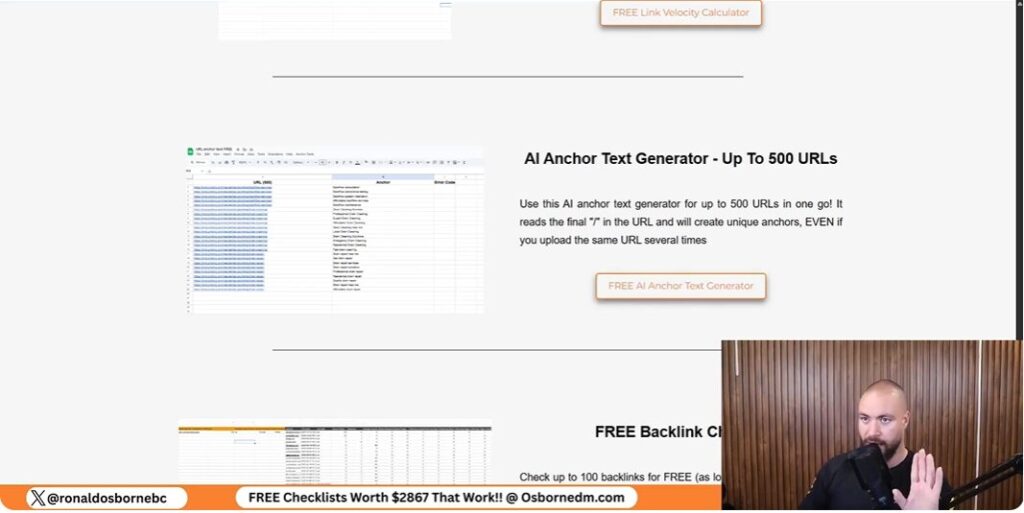
If you’ve ever managed SEO for multiple pages, you know the pain: endless lists of URLs, each needing unique, relevant anchor text. I used to spend hours brainstorming anchors, only to end up with repetitive or off-topic phrases. Worse, I’d sometimes mix up services - like using “drain cleaning” anchors for a “drain repair” page. It was a mess, and it made scaling campaigns nearly impossible.
That frustration pushed me to automate the process. I wanted a tool that could handle hundreds of URLs, generate targeted anchor text, and adapt to different services and locations - without me losing my mind.
So, I built a Google Sheets tool powered by AI. Here’s what it does:
Getting started is simple. All you need is your own OpenAI API key. Here’s how you set it up:
open_API_API_key (exactly as shown).If there’s an issue with your API connection, the tool gives you an error code so you can troubleshoot quickly.
No tool is perfect, and automation comes with quirks. The AI is smart, but if your URLs are too generic - like “Palm Beach County services” - the anchor text might not be spot-on. The script tries to check the homepage for extra clues, but it’s not always precise. For best results, use specific URLs (e.g., “roofing services Palm Beach County”).
In my tests, the tool got it right about 80% of the time (four out of five cases). For most local SEO campaigns, that’s more than enough, especially when you need hundreds of unique anchors. Just make sure you don’t have duplicate URLs before you run the sheet.
Remember: while AI-generated anchor text is fast and scalable, it might not have the subtlety of hand-written copy. Still, for bulk campaigns, this free tool is a game-changer.
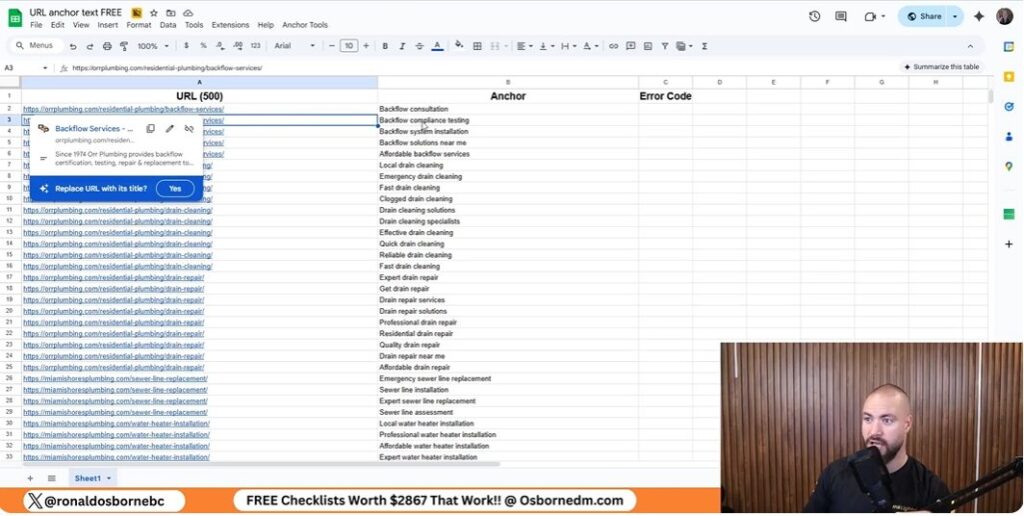
If you’ve ever tried to automate your SEO, you know that anchor text can be both oddly satisfying and a little bit maddening. Before you optimize SEO anchor text with AI, it’s crucial to understand the different types of anchor text - and why they matter. Let’s break down the main types, see real examples from my spreadsheet tool, and talk about why getting them right is so important for your SEO.
Let’s look at how my spreadsheet tool handles different types of pages:
www.miamiplumbing.com/drain-cleaning, the AI generates anchors like drain cleaning Miami or professional drain cleaning.www.miamiplumbing.com/miami, you might see plumbing services Miami or Miami plumbers.www.miamiplumbing.com/blog/how-to-drain-your-pool-safely, expect anchors like how to drain your pool safely or pool draining tips.www.miamiplumbing.com, the tool might default to Miami Plumbing or just the naked URL, especially if your homepage isn’t specific about services.One of the biggest pitfalls is mixing up similar services. For example, using drain repair as anchor text for a drain cleaning page. This confuses Google and your users. My AI tool is engineered to avoid this by analyzing the last part of the URL and matching the anchor text to the actual service. But, if your URL is too generic - like /services - the tool might guess wrong, so always keep your URLs specific.
The AI in my spreadsheet tool isn’t psychic. It prioritizes the final segment of the URL, checks for keywords, and even looks at the homepage for clues if the URL is vague. This works about 80% of the time, but sometimes it’ll generate a generic anchor for a generic URL. That’s why I recommend structuring URLs clearly and reviewing the results before deploying them.
“Anchor text is like seasoning - too much of one type ruins the dish. Mix it up, keep it relevant, and let the AI do the heavy lifting (with a little human oversight).”

When I first built my AI-powered anchor text spreadsheet, I was honestly blown away by how much time it saved. But as with any tool, there are some surprising benefits - and a few quirks - you should know about before you let the robots take the wheel. Here’s what I’ve learned from using this tool to optimize SEO anchor text with AI on real SEO campaigns, especially for local businesses and service pages.
Let’s start with the obvious: speed. With my spreadsheet, you can drop in a list of 100 URLs and have optimized anchor text for every single one in just a couple of minutes. Even if you max out the tool with 500 URLs, you’re looking at about five minutes, tops. No human can match that pace - not even close. If you’ve ever tried to write unique anchors for hundreds of backlinks by hand, you know it’s a soul-crushing task. AI makes it painless.
It’s not just about speed - it’s about volume. The tool generates unique anchor text every single time, even if you use duplicate URLs. That means you can build out massive backlink campaigns without worrying about repetitive anchor text, which is a huge plus for natural link profiles. For most local or small business campaigns, you’ll never need more than what this tool can produce.
This AI approach is especially effective for local SEO. The spreadsheet is designed to handle geo-specific pages (like “plumbing Miami” or “roofing Palm Beach County”) and can distinguish between similar services, so you don’t end up with mismatched anchors. For small businesses or agencies managing lots of clients, this is a game-changer. You get fast, relevant anchors that help you scale your outreach without burning out.
Here’s where things get a bit less magical. While the AI is smart, it doesn’t do deep-dive competitor analysis. If you want to reverse-engineer exactly what anchor text your competitors are using - and then one-up them - you’ll still need to do that part manually or use a premium tool. My free sheet focuses on speed and accuracy, not on spying. For most campaigns, that’s fine, but for ultra-competitive niches, human research still rules.
AI is only as good as the data you feed it. If your URLs are generic - think “Palm Beach County services” - the tool might not know if you’re a roofer, a plumber, or a dog walker. It tries to check your homepage for clues, but sometimes the anchor text it generates can be off. That’s why I always recommend using specific, descriptive URLs (like “roofing-services-palm-beach-county”). And yes, sanity checks are not optional. Always scan your anchor list before hitting “send” on your outreach.
Bottom line: AI anchor text generation is a massive time-saver, but you still need to keep an eye on the results - especially if your URLs aren’t crystal clear. For most local SEO campaigns, though, it’s more than enough to keep your sanity intact.
Let’s get down to the real mechanics of anchor text - the numbers, the ratios, and the sanity-saving shortcuts I’ve learned after years of trial, error, and a few close calls with Google’s Penguin update. If you’re using my free anchor text spreadsheet, you’ll want to know not just how to generate anchors, but how to balance them for a natural, penalty-resistant backlink profile. Here’s how I approach anchor distribution, why it matters, and how my tool helps you stay on track.
First, let’s talk about the ideal anchor text mix. In my experience, a healthy backlink profile is like a well-balanced diet: too much of one thing, and you’re asking for trouble. Generally, I aim for something like this:
| Anchor Type | Recommended % | Example |
|---|---|---|
| Branded | 30-40% | “Acme Plumbing Miami” |
| Generic | 20-30% | “Click here”, “Visit site” |
| Exact Match | 10-15% | “drain repair Miami” |
| Partial Match | 10-15% | “Miami drain cleaning services” |
| URL/Naked | 10-15% | “www.acmeplumbing.com/drain-repair” |
This table isn’t gospel, but it’s a solid starting point for most local and small business campaigns. The key is variety. My spreadsheet is designed to help you avoid the biggest anchor text mistake: repetition. Never use the same anchor text twice in your campaign - Google’s algorithms are quick to spot patterns, and nothing screams “unnatural” like a dozen links with identical anchors. The tool randomizes and customizes anchors, even for duplicate URLs, so you’re always covered.
One of the best sanity checks you can do is to periodically export your anchor text list from the sheet and compare it to the table above. If you see too many exact matches or branded anchors, adjust your next batch. The spreadsheet makes this easy by generating unique, context-aware anchors each time, but it’s still up to you to keep an eye on your overall distribution.
Here’s my hard-won tip: when in doubt, go branded or generic. If you’re unsure about what anchor to use, a branded term or a generic phrase is always safer than risking over-optimization. I’ve seen too many sites get hit by Penguin for pushing exact match anchors too hard. Remember, natural profiles are messy - embrace the chaos a little!
In conclusion, the combination of my AI-powered spreadsheet and a smart anchor distribution plan can save you hours and protect your site from penalties. Use the table above as your anchor sanity guide, never repeat anchors, and don’t be afraid to lean on branded or generic terms. With these habits, you’ll keep your SEO both automated and safe - and maybe even find the process a little satisfying, too

I built the Reddit Scraper to give you unlimited real-world content ideas and warm leads without running ads. This guide walks you through setting up the sheet, configuring the tool, running scrapes, and using the outputs to create content, do market research, and find outreach opportunities.

The Reddit Scraper connects Google Sheets to the official Reddit API to pull structured data from subreddits or keyword searches. It runs in two modes so you can do both quick scans and deep conversation retrieval:
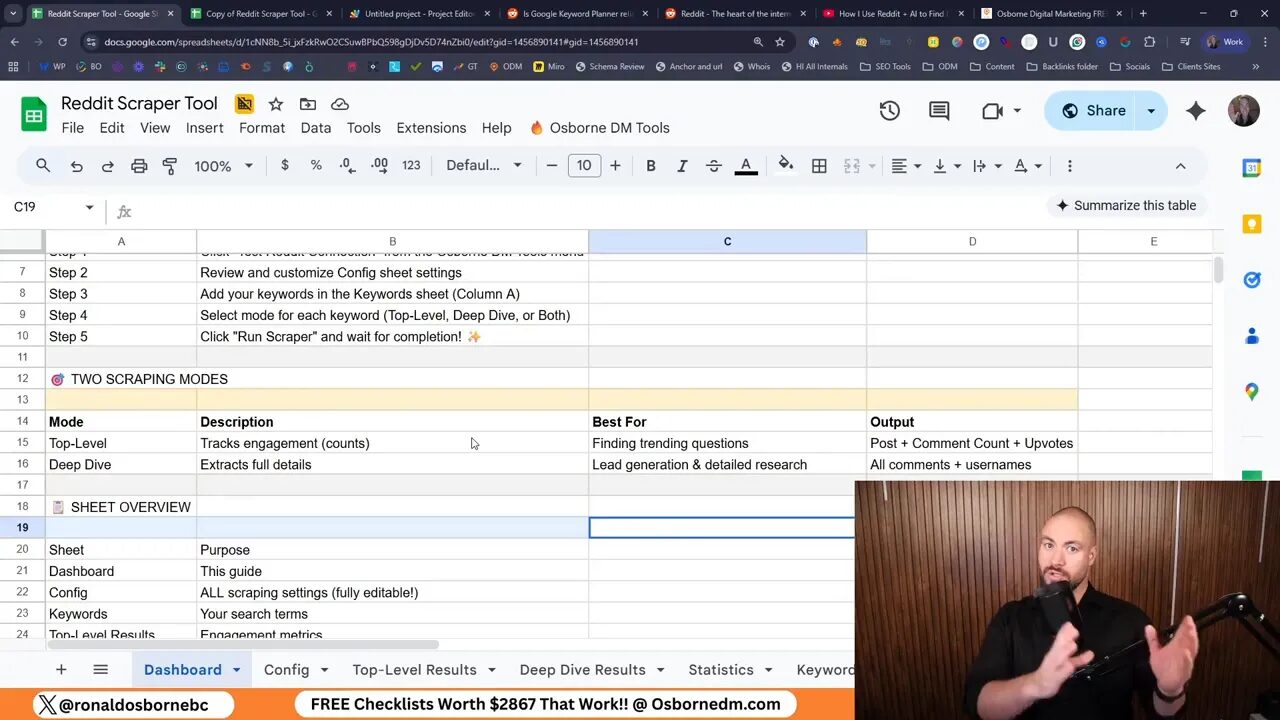
Every day your customers ask questions on Reddit and your competitors are often too slow to answer. The Reddit Scraper finds those questions, scores engagement so you can prioritize, and extracts comment threads so you can research or reach out to active users. It is free, runs entirely in Google Sheets, and uses the official Reddit API so the data is clean and reliable.
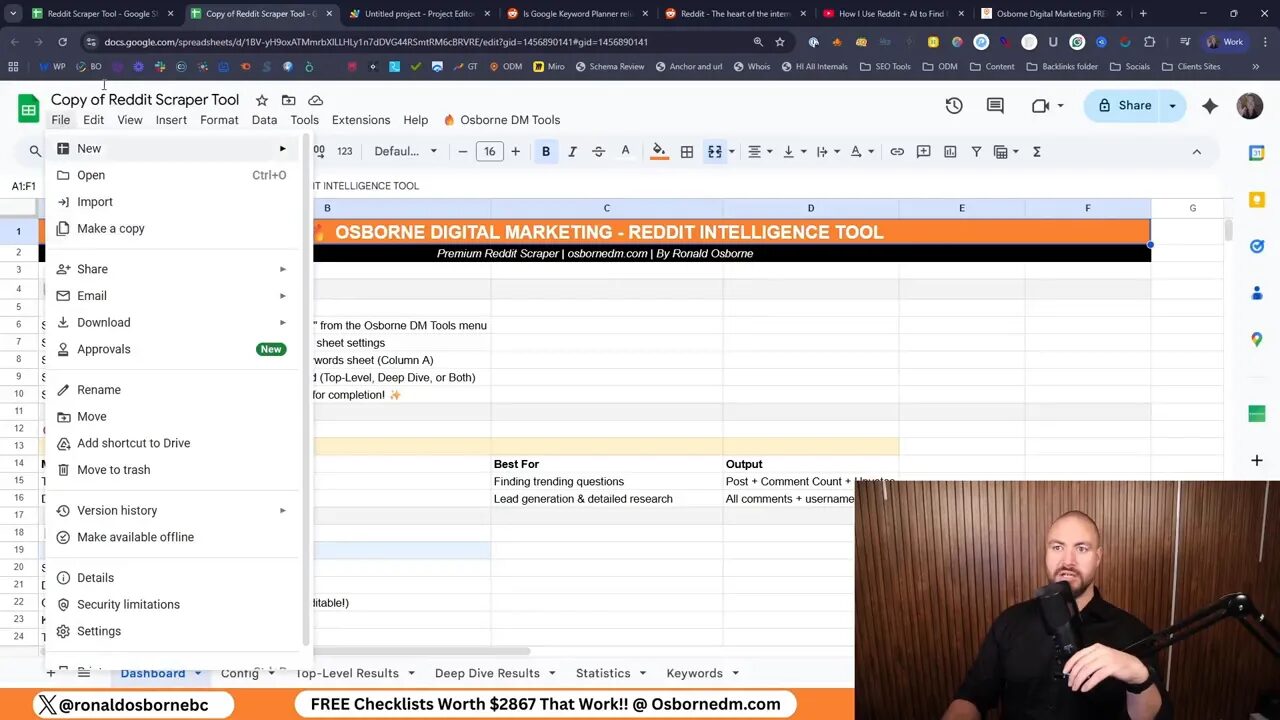
Open the Config tab and choose which mode to enable. I recommend keeping one mode on at a time for clarity. Key settings to adjust:
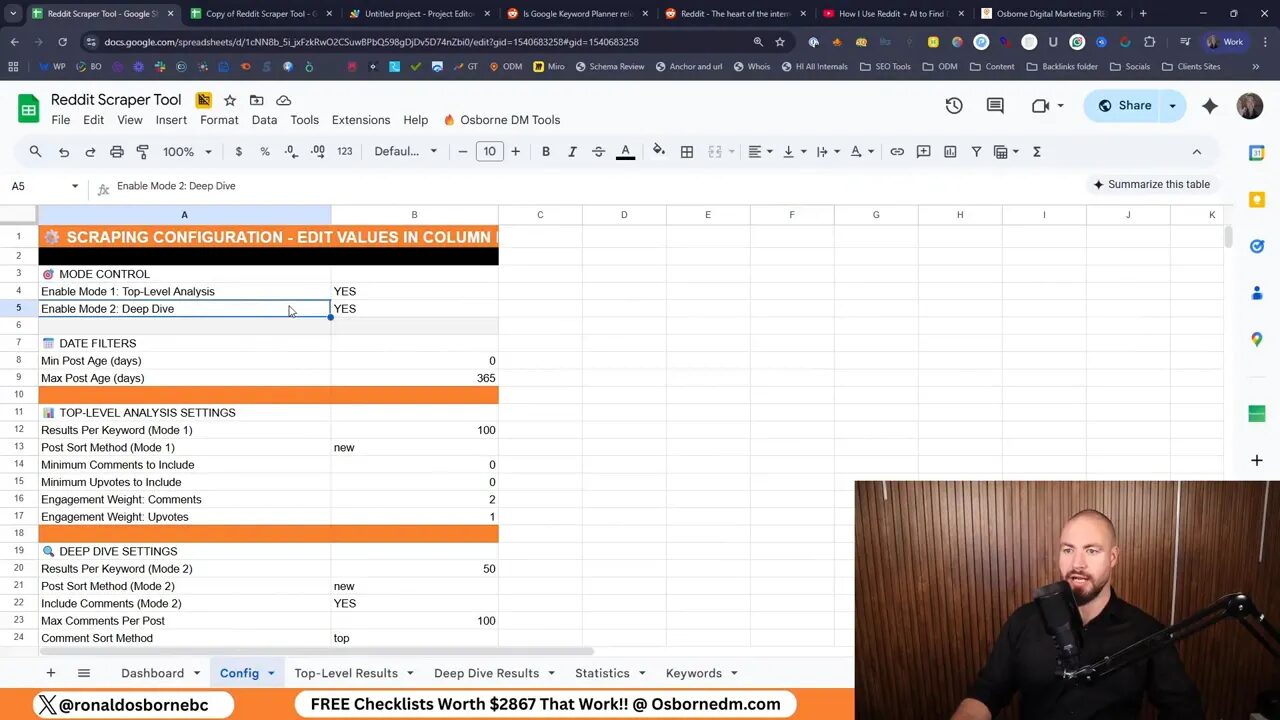
On the Keywords sheet add targets in three columns: type (subreddit or search), the subreddit or keyword, and the mode (top-level or deep dive). For example, add r/SEO as a subreddit type or add "local SEO tips" as a search term. The Reddit Scraper can run both approaches concurrently so you get the best of both worlds.
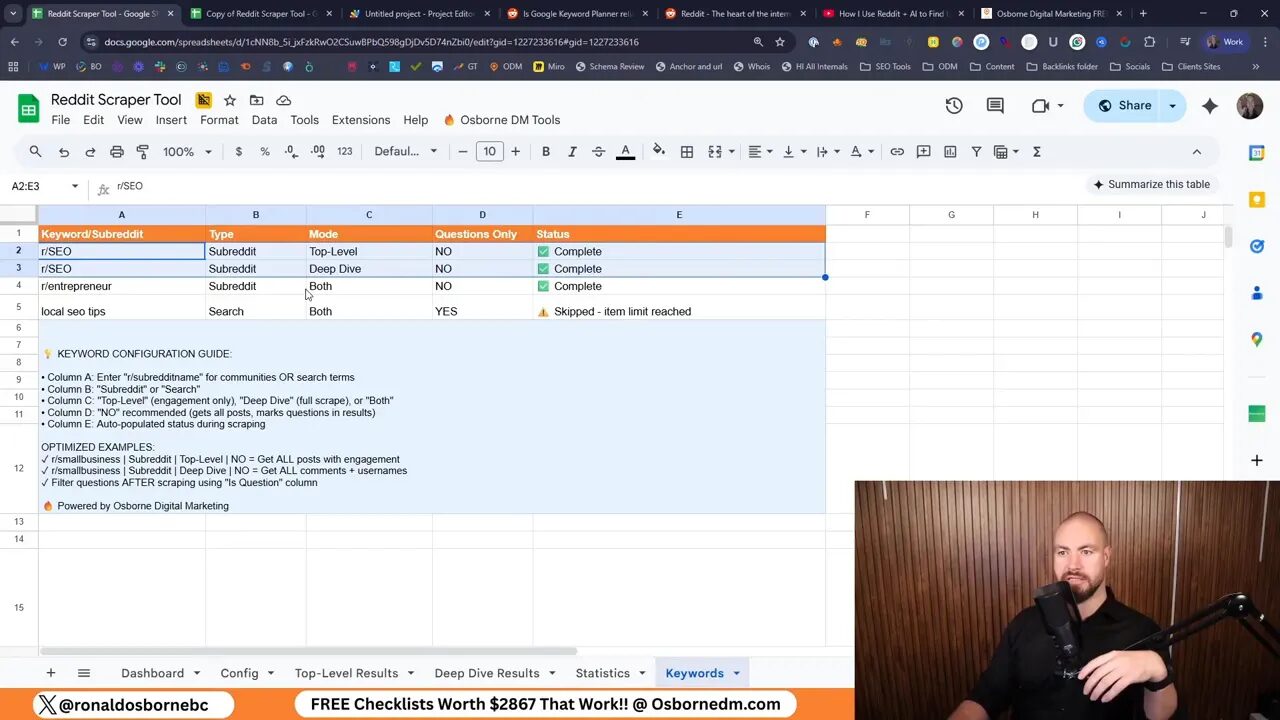
Open Osborne DM Tools and click Run Scraper. Depending on your limits, scrapes can take anywhere from a few minutes to 20 minutes or more. Watch the Statistics sheet for runtime, item counts, and success rates.
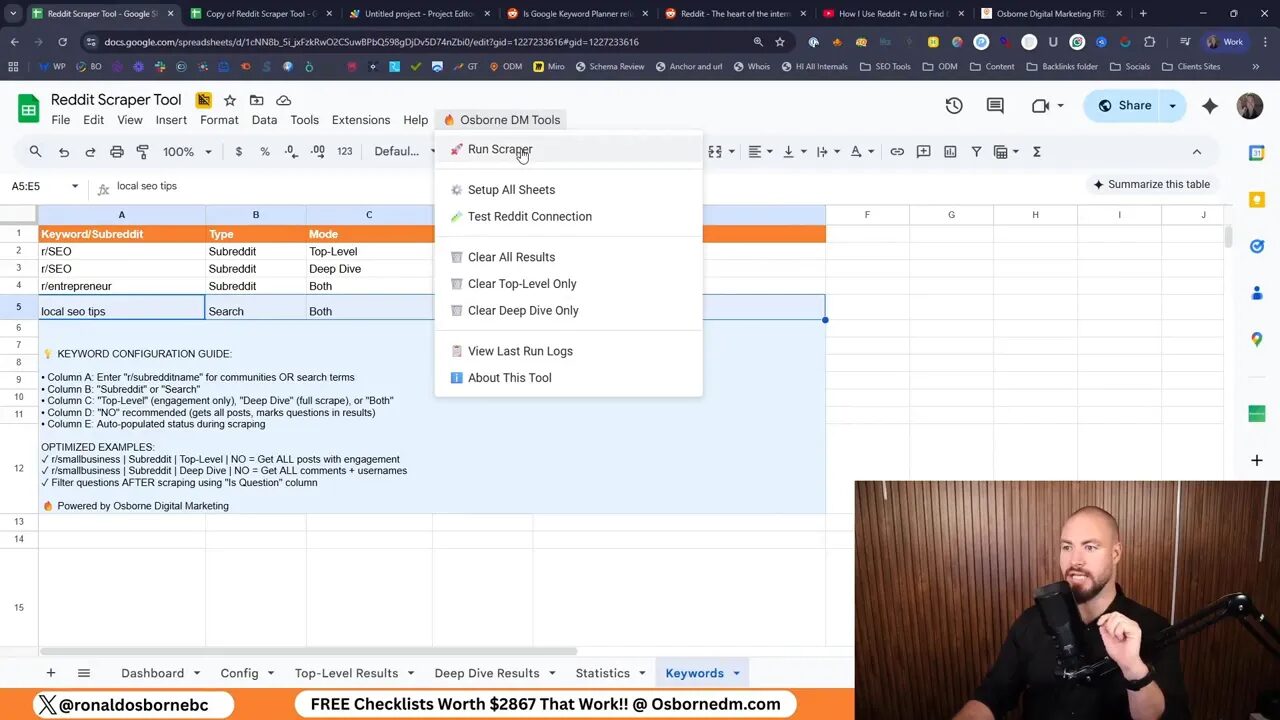
After the scrape completes review two places:
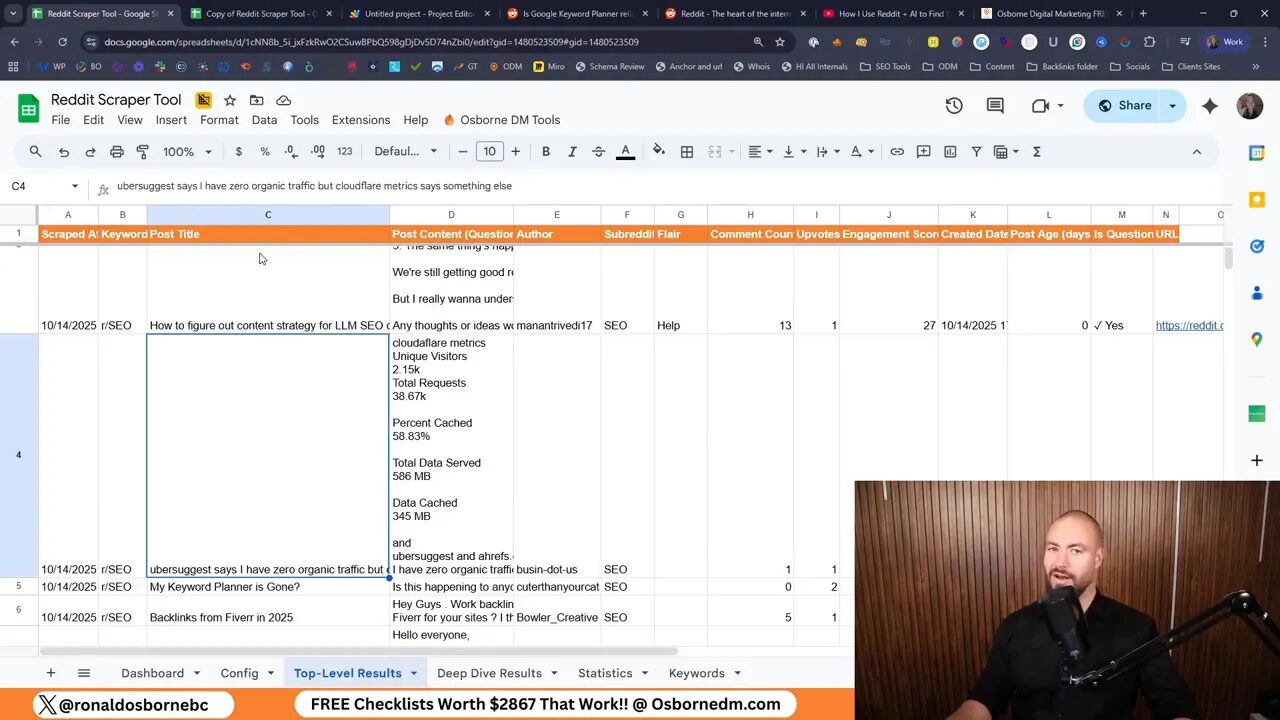
The sheet also calculates an engagement score weighted by comments and upvotes. Use that to prioritize threads that deserve your attention first.
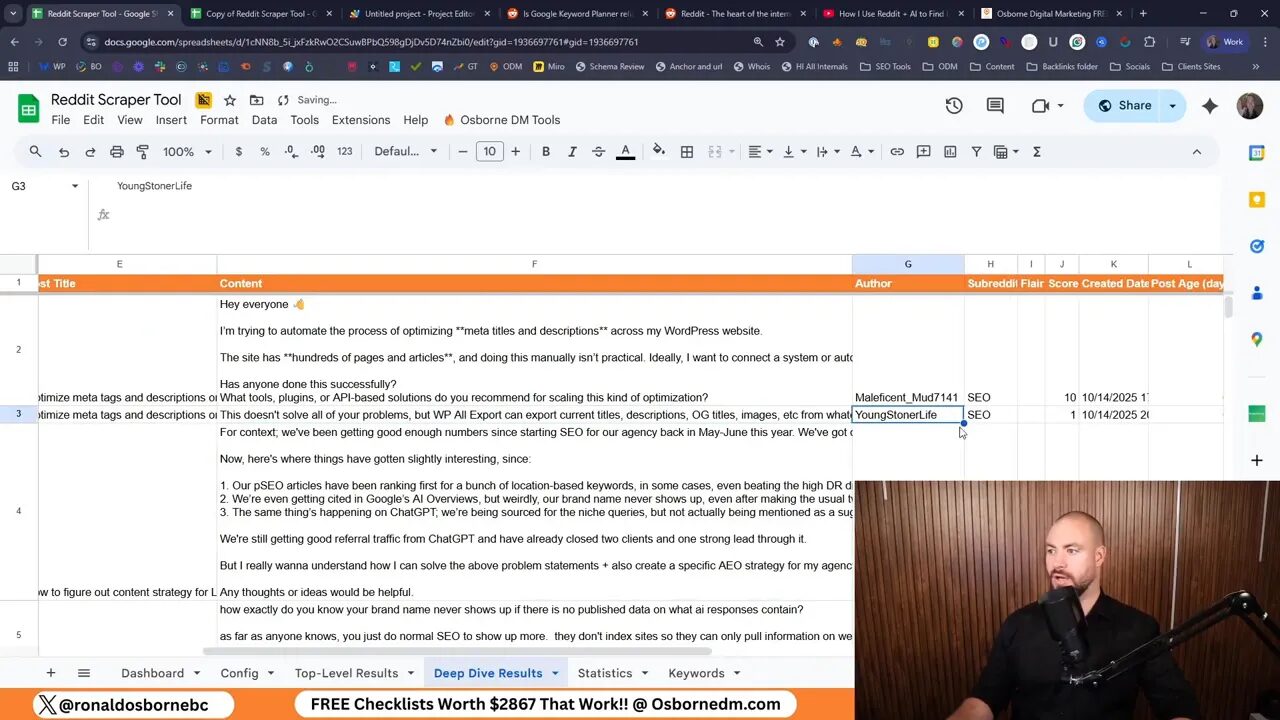
Use the Reddit Scraper to discover real questions you can answer with blog posts, videos, or social content. For lead generation, export the deep-dive user data and reach out to active contributors who demonstrate intent or need. The tool gives you the live URL to the post; from there you can visit the thread and engage respectfully.
Tips:
I built this sheet from inspiration found on GitHub and turned it into a friendly Google Sheets tool. If you want help setting it up or running an SEO campaign using the output, join the community group or book a discovery call.
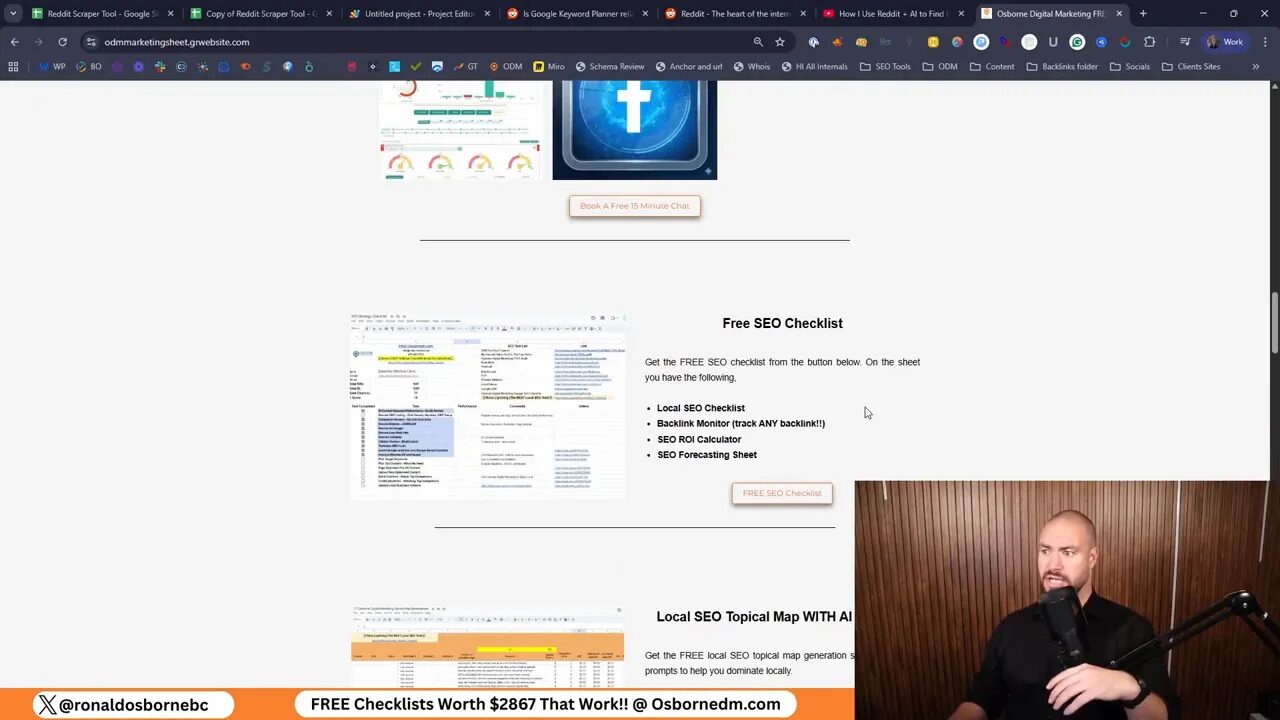
The Reddit Scraper gives you a low-friction way to turn real Reddit discussions into content ideas and lead opportunities. Make a copy, set your API, tweak the config, and let the sheet surface the conversations your customers are having right now. Connect with Ronald Osborne the marketing and consulting expert today!
When I first started dipping my toes in the world of SEO, the sheer complexity of it all was overwhelming. I remember feeling like everyone else was speaking a different language, while I was just trying to grasp the basics. Then, I stumbled across EEAT - experience, expertise, authoritativeness, and trustworthiness. Learning how to harness EEAT changed my approach to online content creation. Let me take you on a journey into understanding what is EEAT and how it can transform your SEO game.
TL;DR: Unlock the secrets of EEAT in SEO to enhance your content's authoritativeness, boost your rankings, and build trust with your audience. Learn effective strategies to leverage these principles in your website and social profiles.
When we talk about SEO, one term that often comes up is E-A-T. But what does it really mean? E-A-T stands for Experience, Expertise, Authoritativeness, and Trustworthiness. Each of these components plays a crucial role in how content is evaluated online. Let’s break it down.
First, let’s define each part of EEAT:
So, why should we care about E-A-T? Well, Google uses these criteria in its algorithms to rank content. The better your E-A-T, the higher your chances of ranking well. It’s that simple.
Google’s algorithms are designed to provide users with the best possible search results. They evaluate content based on E-A-T to ensure that users receive accurate and reliable information. For example, if you’re searching for investment advice, Google wants to show you content from someone who knows what they’re talking about. This is where E-A-T comes into play.
According to Google’s search quality guidelines, content that demonstrates high E-A-T is more likely to rank higher. This means that if you’re creating content, you need to focus on building your E-A-T. It’s not just about keywords anymore; it’s about proving you’re a credible source.
The COVID-19 pandemic has highlighted the importance of E-A-T more than ever. With so much misinformation circulating, people are looking for reliable sources. Google has responded by tightening its focus on E-A-T, especially for “Your Money or Your Life” (YMYL) topics, which include finance and health.
During the pandemic, I noticed that content creators who had established E-A-T were more successful in reaching their audience. This was particularly true for those providing health advice or financial guidance. Users wanted to know they were getting information from trustworthy sources.
In my experience, building E-A-T isn’t just beneficial; it’s essential. Here are some steps you can take to enhance your E-A-T:
By focusing on these areas, you can improve your E-A-T and, in turn, your SEO rankings. It’s a journey, but one that’s worth taking.
In summary, understanding E-A-T is crucial for anyone looking to improve their online presence. It’s not just about creating content; it’s about creating trustworthy, authoritative content that resonates with your audience. As we navigate this digital landscape, let’s keep E-A-T at the forefront of our strategies.
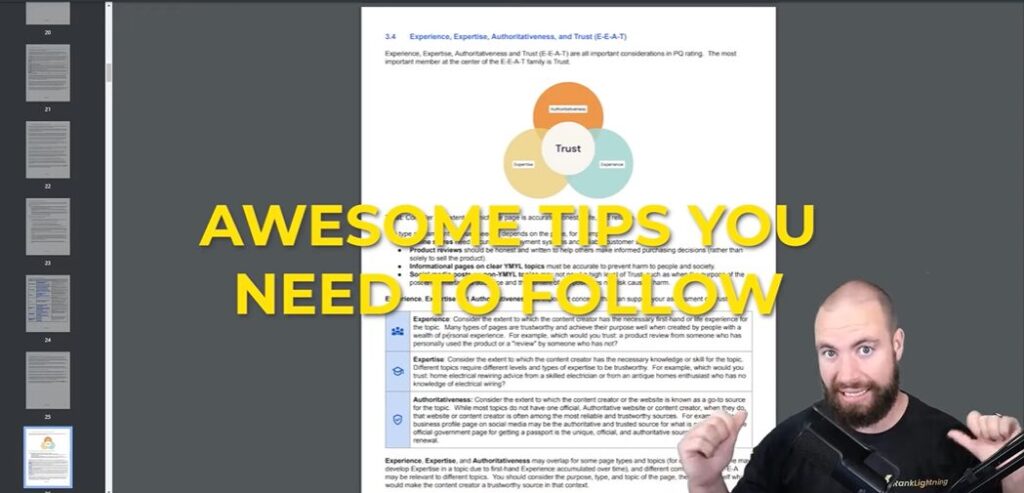
When I first started my career in finance, I was just a fresh graduate with an MBA. I remember feeling overwhelmed by the vastness of the industry. It wasn’t just about numbers; it was about understanding the market, investment strategies, and the psychology behind financial decisions. I made it a point to immerse myself in real-world experiences. I worked with seasoned professionals, learned from their successes and mistakes, and gradually built my own expertise.
One of my early projects involved helping a small business streamline its financial operations. It was a challenging task, but I learned so much. I realized that hands-on experience is invaluable. It’s one thing to read about finance in textbooks, but applying that knowledge in real scenarios is where true learning happens. This blend of education and experience has been crucial in establishing my credibility in the finance sector.
Credentials matter. They serve as a foundation for your authority in any field. In finance, having an MBA is a great start, but it’s not the end of the story. I’ve seen many professionals with impressive degrees fail to gain traction online because they didn’t effectively communicate their expertise. Personal branding plays a significant role here.
Think about it: if you’re looking for financial advice, would you trust someone without any credentials? Probably not. That’s why I emphasize the importance of showcasing your qualifications. Whether it’s through a dedicated website, an about page, or social media profiles, make sure your audience knows who you are and what you bring to the table.
Let’s take a look at some businesses that have successfully leveraged their expertise to gain traffic. One example that stands out is a financial advisory firm I came across. They started a blog sharing insights on investment strategies, market trends, and personal finance tips. Their team consisted of certified financial planners and investment analysts, and they made it a point to highlight their credentials in every post.
As a result, their website traffic skyrocketed. They not only attracted readers but also converted many into clients. Their success wasn’t just about the quality of their content; it was about the trust they built through their expertise. They demonstrated that they knew what they were talking about, and people responded.
Another example is a YouTube channel focused on stock market analysis. The creator, who has years of experience in trading, shares his insights regularly. His channel has grown to over 100,000 subscribers. Why? Because he provides valuable, actionable advice backed by his extensive experience. Google recognizes his authority, and as a result, his videos rank high in search results.
So, how can you start building your own expertise online? Here are a few tips:
Remember, establishing your expertise online is a journey. It takes time, consistency, and a genuine commitment to sharing your knowledge. But with the right approach, you can build a credible online presence that resonates with your audience.
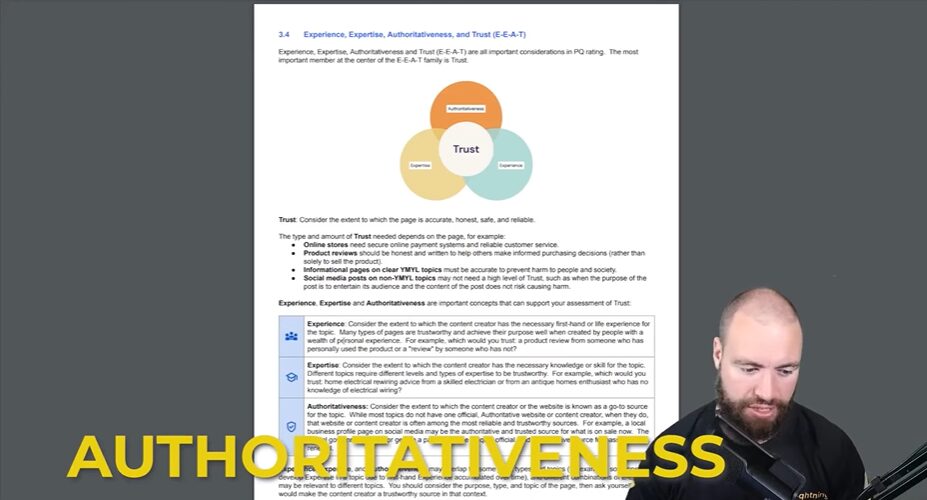
Establishing authority online is crucial in today’s digital landscape. It’s not just about having a website; it’s about being recognized as a credible source. So, how can we boost our online visibility and authority? Let’s dive into some effective strategies.
Social media is a powerful tool. It can amplify your voice and reach a broader audience. But how do we make the most of it? Here are some tips:
Think of social media as a party. You wouldn’t just stand in the corner; you’d mingle, share stories, and connect with others. The same goes for your online presence. Be active and approachable.
Guest posting is another effective way to build authority. Writing for reputable sites can enhance your credibility. Here’s how to approach it:
Imagine you’re invited to speak at a prestigious conference. That’s what guest posting feels like. It’s an opportunity to showcase your expertise to a new audience.
Structured data markup, like schema, is a technical yet essential aspect of SEO. It helps search engines understand your content better. Here’s why you should consider it:
Think of structured data as a roadmap for search engines. It guides them through your content, ensuring they understand what you’re all about.
Google emphasizes E-A-T: Experience, Authoritativeness, and Trustworthiness. Understanding this concept is vital for anyone looking to improve their SEO. Here’s a breakdown:
Incorporating E-A-T into your strategy can significantly enhance your online presence. It’s not just about what you say; it’s about how you say it and the credibility behind it.
By focusing on these strategies, we can create a robust online presence that resonates with our audience and establishes us as authorities in our fields. Remember, building authority takes time, but with persistence and the right approach, we can achieve it.

When it comes to SEO, one term that keeps popping up is E-A-T. It stands for Experience, Authoritativeness, and Trustworthiness. Understanding and applying what is EEAT can significantly improve your website's ranking on Google. But how do we do that? Let's dive into some practical strategies for implementing E-A-T in our daily content creation.
First off, we need to establish our credentials. This is where experience comes into play. If you have a background in a specific field, flaunt it! Share your qualifications, and don’t shy away from personal stories that showcase your expertise. For example, I hold an MBA in finance, which gives me a solid foundation to discuss investment strategies. This blend of education and real-world experience builds my credibility.
Next, consider creating a dedicated About page on your website. This page should outline who you are, your qualifications, and what makes you an expert in your field. It’s like a handshake with your audience. They want to know who they’re dealing with. Also, link your social media profiles—like LinkedIn and Twitter - to your website. This not only enhances your online presence but also boosts your credibility.
Another effective strategy is to implement author schema on your website. This helps search engines understand who you are and what you do. The more information you provide, the better your chances of being recognized as an authority in your niche.
Now, let’s talk about YMYL, which stands for Your Money or Your Life. These are topics that can significantly impact a person's life, such as finance, health, and legal matters. Google is particularly cautious about the information it ranks for these sensitive topics. Misinformation can lead to serious consequences for users. Therefore, establishing a solid E-A-T framework is crucial if you want to rank competitively in these areas.
For instance, if you’re writing about financial advice, ensure that your content is accurate and well-researched. Google looks for content that not only provides value but also comes from credible sources. If you can demonstrate your expertise in these areas, you’re more likely to gain the trust of both Google and your audience.
So, what kind of keywords and topics benefit from applied E-A-T? Here are a few examples:
By focusing on these topics and ensuring your content reflects your expertise, you can improve your chances of ranking higher in search results.
Another critical aspect of E-A-T is building authority through backlinks. Acquiring links from reputable sites can significantly boost your perceived authority. For example, if you can get a link from a well-known site like Entrepreneur or Forbes, it signals to Google that you are a credible source. This can lead to better visibility in search rankings.
Participating in podcasts or guest blogging can also help you gain visibility. While the return on investment may vary, appearing on larger platforms can widen your audience. Consistency is key; using the same name for branding helps build a cohesive online presence.
In summary, understanding and implementing E-A-T concepts is crucial for navigating the SEO landscape effectively. By focusing on experience, authoritativeness, and trustworthiness, we can improve our website's ranking in Google. Let’s get to work on building our E-A-T strategy!
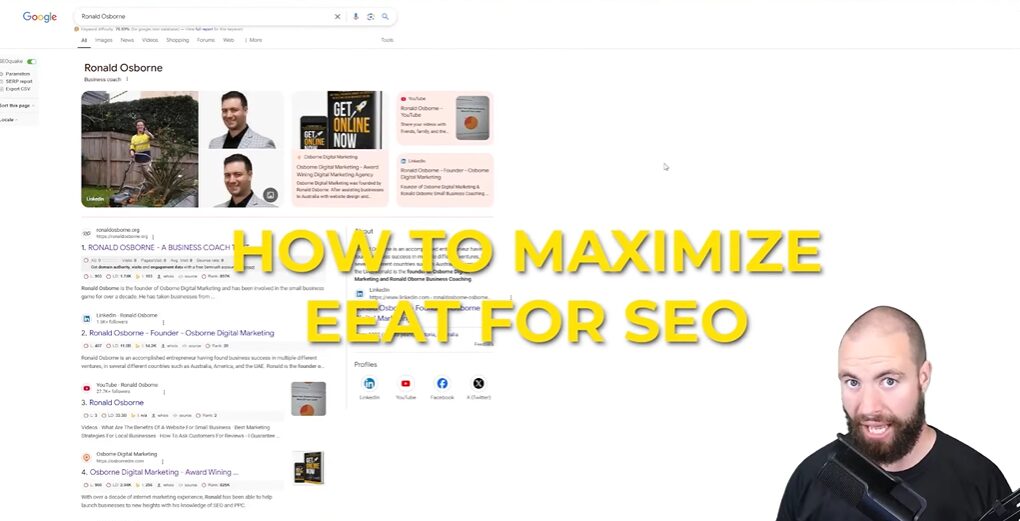
As we look to the future of SEO, one thing is clear: the emphasis on E-A-T - Experience, Authoritativeness, and Trustworthiness - is only going to grow. I’ve seen firsthand how vital it is to adapt to these changes. It’s not just a trend; it’s a fundamental shift in how we approach content creation and online visibility.
So, what does the future hold? I believe we will see a stronger focus on E-A-T across all niches. Google is continuously refining its algorithms to prioritize content that demonstrates these qualities. For example, if you’re writing about health or finance, your qualifications and experience will matter more than ever. This is especially true for "Your Money or Your Life" (YMYL) topics, where misinformation can have serious consequences.
Imagine this: you’re searching for investment advice. Would you trust a blog post from someone with an MBA and years of experience in finance, or from a random person with no credentials? The answer is obvious. As content creators, we must showcase our expertise and build our authority. This is where E-A-T comes into play.
Google’s algorithms are not static. They evolve constantly, and we need to keep up. Over the years, I’ve noticed how Google has shifted its focus from just keywords to a more nuanced understanding of content quality. E-A-T is now a cornerstone of this evolution. Google wants to ensure that users receive accurate, reliable information. This means that if you’re not prioritizing E-A-T, you risk falling behind.
For instance, I’ve been able to outperform paid competitors in niches like carpet cleaning by focusing on my E-A-T. By demonstrating my experience and authority, I’ve gained trust from both Google and my audience. This is a clear indicator of how essential E-A-T has become in ranking well.
Now, how can we future-proof our strategies? Here are some actionable steps:
By following these strategies, we can enhance our E-A-T and improve our chances of ranking well in the future. Remember, it’s not just about creating content; it’s about creating valuable, trustworthy content that resonates with your audience.
In conclusion, navigating the future of SEO requires a keen understanding of what is EEAT. As we move forward, we must adapt to the changing landscape of Google’s algorithms. By focusing on our experience, building our authority, and establishing trust, we can position ourselves for success. The road ahead may be challenging, but with the right strategies in place, we can thrive in this ever-evolving digital world. Let’s embrace the future together and make E-A-T our guiding principle.
I remember sitting in my home office just a few years ago, pondering the rapid evolution of digital marketing - it's astonishing how fast the landscape shifts. Now, as we approach 2025, the future of SEO seem even more monumental. AI technologies are reshaping how we search, and I've gathered some insights that will help you navigate this new terrain effectively.
TL;DR: SEO is changing rapidly in 2025 with AI-driven search functions dominating results. This post outlines strategies to adapt, focusing on the importance of powerful backlinks and the shifting landscape of local SEO.
As I dive into the world of search engine optimization, one thing becomes crystal clear: AI is taking the lead. It’s reshaping how we think about search results and the strategies we use to reach our audiences. But what does this mean for us? Let’s break it down.
AI is no longer just a buzzword; it’s a game-changer. Think about it: when you type a query into Google, AI algorithms are working behind the scenes to deliver the most relevant results. These algorithms analyze countless factors, including user behavior and content quality, to refine what you see. This means that the days of basic keyword stuffing are fading fast.
Instead, we need to focus on creating high-quality content that resonates with users. If AI can understand context and intent, then our content must be crafted with that in mind. It’s not just about answering questions anymore; it’s about providing comprehensive, engaging answers that keep users on the page.
Now, let’s talk about the future. I predict that we’ll see a rise in curated listicles generated by AI. Imagine searching for "best roofers in Miami" and getting a neatly formatted list of options, complete with reviews and ratings. This isn’t just a dream; it’s a likely reality as Google continues to refine its AI capabilities.
Why is this important? Because it changes the way we approach content creation. Instead of just focusing on traditional blog posts, we need to think about how we can create content that fits into these AI-generated formats. Listicles and detailed guides will become essential tools for capturing attention in a crowded digital landscape.
We’re witnessing a significant shift from traditional SEO methods to AI-driven models. This is not just a trend; it’s a transformation. As Ronald Osborne pointed out in his video, the value of organic search may decrease if AI can effectively answer user queries. This means we need to adapt.
It’s a lot to take in, right? But the key takeaway is that AI is here to stay, and it’s reshaping our approach to search. We can’t ignore it. Instead, we need to embrace it and find ways to leverage its capabilities to our advantage.
In this rapidly changing environment, staying ahead of the curve is essential. As we adapt to these shifts, let’s remember that while SEO is evolving, it’s not dead. It’s simply transforming, and we have the opportunity to lead the charge.
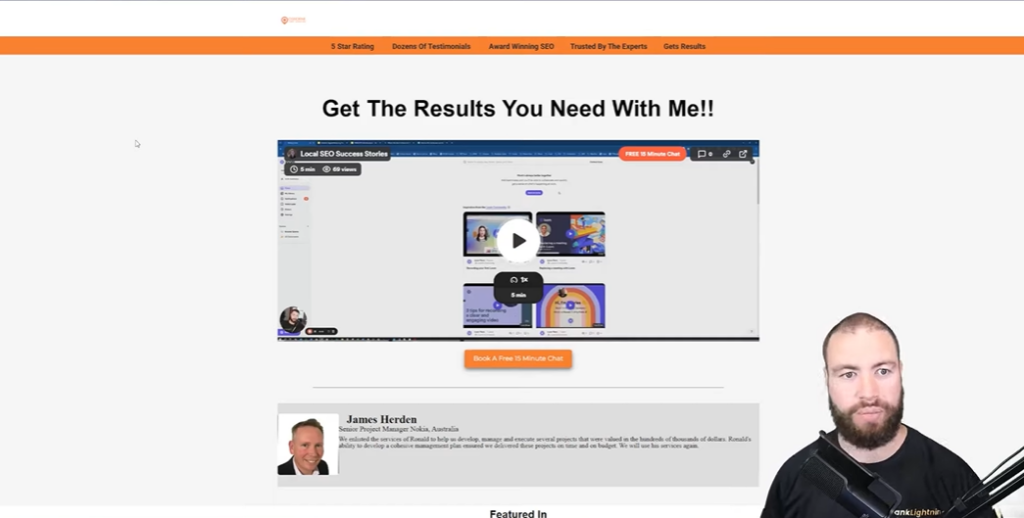
As I dive into the changes happening in local SEO, I can’t help but feel a mix of excitement and concern. The landscape is shifting, and we need to stay ahead of the curve. Let’s explore some key areas that are likely to shape our strategies moving forward.
First off, let’s talk about Google Maps. It’s more than just a navigation tool; it’s a critical part of local SEO. But what’s next for Maps? I believe we’re on the brink of significant changes. Google is always refining its algorithms, and I suspect they’ll tighten the reins on how businesses can optimize their presence.
Imagine this: you search for “best coffee shop near me,” and instead of a straightforward list, you get a curated selection based on AI-driven insights. This could mean less visibility for smaller businesses. If Google prioritizes certain listings, how will we ensure our clients stand out? It’s a real challenge we need to prepare for.
Now, let’s shift gears to advertising. I’ve been following trends closely, and I foresee a significant integration of ads into local search results. Picture this: you’re searching for a local service, and the first few results are paid ads disguised as organic listings. How will users differentiate between the two?
According to Ronald Osborne, “Google’s revenue is heavily reliant on advertising, accounting for about 85% of its income.” This means they’re likely to push paid ads even more aggressively. As marketers, we need to adapt. We might need to rethink our strategies to incorporate paid ads effectively, while still maintaining a strong organic presence.
Despite these challenges, I firmly believe that local SEO tactics are still essential. Why? Because local searches are incredibly powerful. People are looking for services nearby, and if we can position our clients effectively, they’ll reap the benefits.
We must focus on high-quality backlinks and genuine engagement with local audiences. It’s about building relationships, not just rankings. As Osborne points out, “Only high-quality backlinks will be effective.” This means we need to be strategic about our outreach and partnerships.
In conclusion, the dynamics of local SEO are evolving. With potential shifts in Google Maps functionality and increased ad integrations, we need to stay vigilant. But I believe that with the right tactics, we can navigate these changes successfully. Let’s embrace the challenge and adapt our strategies to ensure we remain relevant in this ever-changing landscape.
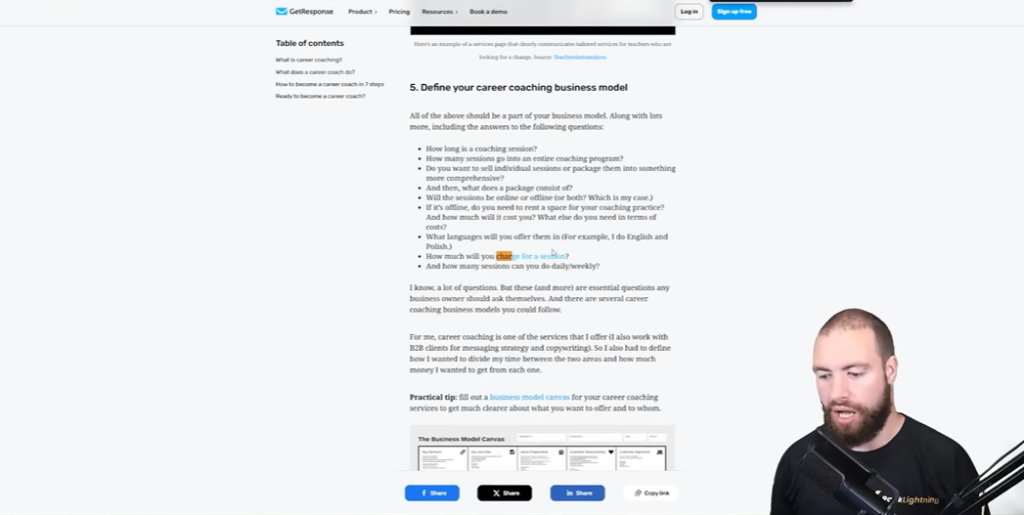
When we talk about backlinks, it’s essential to understand what makes a backlink powerful. A powerful backlink is not just any link pointing to your site. It comes from a reputable, high-authority website. Think of it like a vote of confidence. If a respected site links to you, it signals to search engines that your content is valuable. But what exactly constitutes a powerful backlink?
A powerful backlink typically has the following characteristics:
In essence, powerful backlinks are like endorsements from trusted sources. They can significantly boost your site's credibility and visibility in search results.
Now, let’s talk about the changing landscape of backlinks. In recent years, I’ve noticed a decline in the effectiveness of mid-tier backlinks. These are links from sites that have some authority but aren’t top-tier. They used to provide a decent boost, but as search engines evolve, they’re becoming less impactful.
Why is this happening? Well, search engines are getting smarter. They can now differentiate between high-quality and low-quality links. As a result, mid-tier links are losing their value. It’s like trying to get a recommendation from someone who isn’t well-known in their field. It just doesn’t carry the same weight.
So, what does this mean for us? It means we need to focus on acquiring high-authority backlinks to stay competitive. But how do we do that?
Here are some effective strategies I’ve found useful:
In conclusion, as we navigate the ever-changing world of SEO, focusing on acquiring powerful backlinks is essential. The landscape is shifting, and we must adapt our strategies accordingly. Powerful backlinks are not just a nice-to-have; they are a necessity for anyone looking to thrive in the digital space.

When I think about the role of SEO agencies, I see them as vital players in the digital marketing arena. They are the navigators in a sea of ever-changing algorithms and search engine trends. But what exactly do they do? Let's break it down.
First off, SEO stands for Search Engine Optimization. It’s the practice of enhancing your website so it ranks higher in search engine results. This means more visibility and, ideally, more traffic. But SEO isn’t just about stuffing keywords into your content. It’s a complex mix of strategies that includes:
SEO agencies specialize in these areas, helping businesses navigate the intricacies of search engines. But why is this important? Well, think about it: when was the last time you went past the first page of Google? Exactly.
SEO is not a one-size-fits-all solution. Each business has unique needs and challenges. This is where SEO agencies shine. They bring expertise and experience to the table. They stay updated on the latest trends and algorithm changes. For instance, Ronald Osborne, founder of Osbourne Digital Marketing, emphasizes the growing role of AI in SEO. He predicts that by 2025, AI will dominate search results, making it crucial for businesses to adapt their strategies accordingly.
Imagine trying to navigate a new city without a map. You might find some interesting places, but you’d likely miss out on the best spots. SEO agencies provide that map. They guide businesses through the complexities of digital marketing, ensuring they reach their destination efficiently.
Another key role of SEO agencies is crafting tailored strategies. They analyze your business, your audience, and your competition. Based on this analysis, they develop a customized plan. This plan might include:
As Osborne points out, local SEO will remain relevant, but it may become more challenging due to algorithm changes. This means businesses need to be proactive and adaptable.
SEO is not a set-it-and-forget-it endeavor. It requires ongoing monitoring and adjustments. SEO agencies use various tools to track performance metrics. They analyze data to see what’s working and what isn’t. This allows them to refine strategies continuously.
Think of it like gardening. You plant seeds, but you also need to water them, prune them, and sometimes even change the soil. SEO agencies do the same for your online presence. They ensure your strategies grow and evolve.
As we look toward the uncertain, the future of SEO agencies will only grow. With the rise of AI and changing consumer behavior, businesses will need expert guidance more than ever. As Osborne suggests, those who adapt will thrive, while others may struggle.
In this dynamic landscape, SEO agencies will be the partners that help businesses navigate challenges and seize opportunities. They are not just service providers; they are essential allies in the quest for online visibility and success.

As we look ahead to 2025, it’s clear that the business landscape is shifting. I’ve been diving deep into the trends and predictions, and I want to share some strategies that can help us all stay ahead of the curve. Here are three key areas to focus on:
Market shifts are inevitable. They can be driven by technology, consumer behavior, or even global events. The key is to stay informed and be ready to adapt. For instance, the rise of AI in search engines is a game changer. Ronald Osborne, a digital marketing expert, emphasizes that AI will dominate search results. This means we need to rethink how we approach our online presence.
Are we prepared for a world where basic queries yield AI-generated listicles? If Google is focused on providing quick answers, we might need to adjust our content strategies. Instead of just aiming for organic search rankings, we should consider how we can create content that aligns with AI-generated responses. This could mean focusing on quality over quantity and ensuring our information is easily digestible.
In times of change, collaboration can be our greatest asset. I’ve seen firsthand how forming partnerships with other businesses can lead to innovative solutions. By working together, we can leverage each other’s strengths. This is especially important as competition increases and marketing costs rise.
Osborne suggests that many marketing agencies may struggle in the coming years. This could create opportunities for those of us who are willing to adapt and innovate. By forming synergistic partnerships, we can not only survive but thrive in this evolving landscape.
As advertising costs continue to climb, we must rethink our marketing strategies. It’s no longer enough to rely solely on organic leads. We need to adopt an omnichannel approach. This means utilizing various platforms and methods to reach our audience.
Consider implementing lead magnets or cold emailing strategies to supplement your existing efforts. These tactics can help us extract more value from our current leads. As Osborne points out, the focus should be on enhancing our skills and finding new ways to engage with potential customers.
Are we ready to embrace these changes? It’s crucial that we stay proactive. Upskilling ourselves and our teams can make a significant difference. Whether it’s learning about new digital marketing tools or understanding the latest trends in consumer behavior, investing in our knowledge is key.
In conclusion, as we prepare for 2025, let’s focus on these three strategies: capitalizing on market shifts, exploring partnerships, and adapting our marketing efforts. The future may be uncertain, but with the right approach, we can navigate it successfully.
As I reflect on the ever-evolving future of SEO, one thing becomes clear: change is inevitable. Just like the seasons shift, so too does the world of search engine optimization. We can’t ignore it. We must embrace it. The rise of AI, for instance, is reshaping how we approach SEO strategies. It’s not just a trend; it’s a transformation that’s already underway.
Change in SEO is like the tide; it comes in waves. Each new algorithm update or technological advancement brings a fresh set of challenges and opportunities. I often think about how Google is constantly refining its AI capabilities. It’s fascinating, yet daunting. Basic queries might soon yield curated listicles generated by AI, which means we need to rethink how we create content. Will organic search still hold its value? Or will it fade into the background as AI takes center stage?
We can’t afford to sit back and hope for the best. Instead, we must adapt. As I’ve discussed, the future may see a significant decrease in the importance of organic listings. If AI can provide quick answers, what does that mean for our strategies? We need to be proactive, not reactive.
Staying informed is crucial in this fast-paced environment. I can’t stress enough how vital it is to keep your finger on the pulse of SEO trends. Knowledge is power. By understanding the latest developments, we can make informed decisions that will help us navigate the complexities of search engine algorithms.
For instance, as Google integrates paid ads into AI responses, distinguishing between organic results and paid promotions will become increasingly challenging. This shift could impact how businesses allocate their marketing budgets. Are we prepared for that? It’s essential to stay updated on these trends to avoid falling behind.
As we look toward the future, I encourage everyone to take proactive steps. This isn’t just about survival; it’s about thriving in a changing landscape. One strategy I recommend is focusing on building high-quality backlinks. As mid-tier links lose value, we must prioritize acquiring links from authoritative websites. This shift will be crucial for maintaining our visibility in search results.
Moreover, I believe that forming partnerships with synergistic businesses can amplify our strengths. Together, we can tackle challenges more effectively. It’s about leveraging collective resources to navigate the complexities of SEO.
In conclusion, while SEO is evolving, it’s not dead. We have the opportunity to adapt and grow. By diversifying our marketing strategies and embracing advancements in AI, we can position ourselves for success. Let’s not wait for change to happen; let’s be the change-makers. The future of SEO is bright for those willing to embrace it.
So, let’s stay informed, take proactive steps, and face the future with confidence. Together, we can navigate this exciting journey ahead.
When I first dove into the world of SEO, the concept of backlinks felt overwhelming. It was like trying to crack a secret code. I remember crafting my first piece of content, nervously hitting publish, and then refreshing my analytics obsessively. To my surprise, that content started attracting links seemingly out of nowhere! That experience ignited my passion for creating linkable content, and I'm excited to share my journey and insights with you here.
TL;DR: Discover effective SEO strategies on how to attract backlinks for free by creating linkable content that not only ranks well but also drives organic traffic to your website.
Backlinks are a cornerstone of effective SEO strategy. They are links from one website to another. But why are they so critical for boosting search engine rankings? Well, search engines like Google view backlinks as a vote of confidence. The more quality backlinks you have, the more authoritative your site appears. This can significantly elevate your position in search results.
Think of backlinks as endorsements. When reputable sites link to your content, it signals to search engines that your site is trustworthy and valuable. This can lead to higher rankings. In fact, studies show that pages with more backlinks tend to rank better than those with fewer. It’s a simple yet powerful principle.
Not all backlinks are created equal. The authority of the linking site plays a crucial role. A link from a high-authority site carries more weight than one from a lesser-known site. This is where the concept of domain authority comes into play. It’s a score that predicts how well a website will rank on search engines.
For instance, if I get a backlink from a site like Wikipedia, it’s much more beneficial than a link from a new blog. This is because Wikipedia is seen as a credible source. So, how do we gain these valuable backlinks? Creating quality, linkable content is key. This means producing content that’s not only informative but also engaging.
Backlinks can significantly drive organic traffic to your site. When users see a link to your content on a reputable site, they are more likely to click on it. This increases your site’s traffic without the need for paid ads.
Moreover, backlinks can help you reach new audiences. When your content is shared, it can spread across various platforms, attracting visitors you might not have reached otherwise. For example, I’ve seen how sharing my articles on social media can lead to unexpected traffic spikes. The key is to ensure your content is shareable.
“If you want to rank higher, focus on creating quality content that attracts backlinks.” - Ronald Osborne
In conclusion, backlinks are essential for improving search engine rankings, building authority, and driving organic traffic. By focusing on these areas, we can enhance our online presence and achieve our SEO goals.
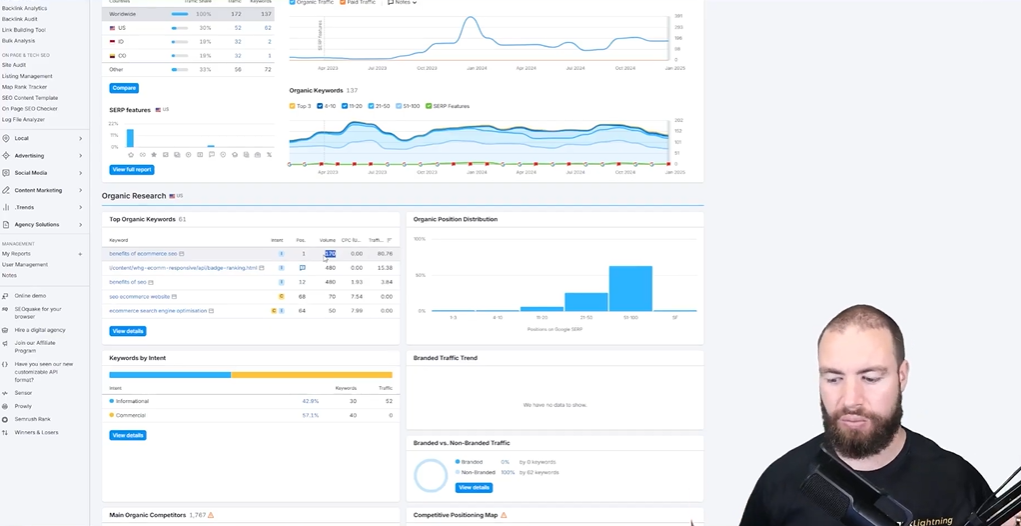
When it comes to creating content that attracts backlinks, keywords are essential. I’ve learned that identifying high-volume, low-difficulty keywords is the first step in this process. But what does that really mean?
High-volume keywords are those that many people search for, while low-difficulty keywords are easier to rank for. Think of it like fishing in a pond. You want to cast your line where the fish are plentiful but not where everyone else is casting theirs. By targeting these keywords, I can create content that stands out without excessive competition.
For example, Ronald Osborne from Osborne Digital Marketing emphasizes the keyword "benefits of e commerce SEO." This keyword gets around 170 searches monthly, but it has minimal competition. It’s a sweet spot that can lead to significant traffic.
Now, how do I find these golden keywords? Tools like SEMrush are invaluable. They allow me to analyze search volume and competition levels effectively. With SEMrush, I can see which keywords are trending and which ones might be worth my time. I also explore questions related to my niche. For instance:
These questions not only target specific interests but also help in crafting content that resonates with my audience. It’s about connecting with what they want to know.
Real-world examples can be incredibly enlightening. Ronald mentions how his content on "benefits of e commerce SEO" attracted twelve backlinks purely because it was relevant and engaging. It’s a reminder that even if I don’t initially target a keyword, creating quality content can still yield results.
Another point to consider is that even average content that ranks number one can secure more backlinks than high-quality content that is lower in the rankings. This insight has changed my approach. Why spend hours crafting the perfect piece if it won’t rank well? Instead, I focus on creating content that has the potential to reach that coveted top position.
In summary, the foundation of linkable content lies in understanding and utilizing keywords effectively. By identifying high-volume, low-difficulty keywords, leveraging tools like SEMrush, and learning from successful examples, I can create content that not only attracts readers but also earns valuable backlinks. The journey of keyword research is both exciting and essential for my online presence.
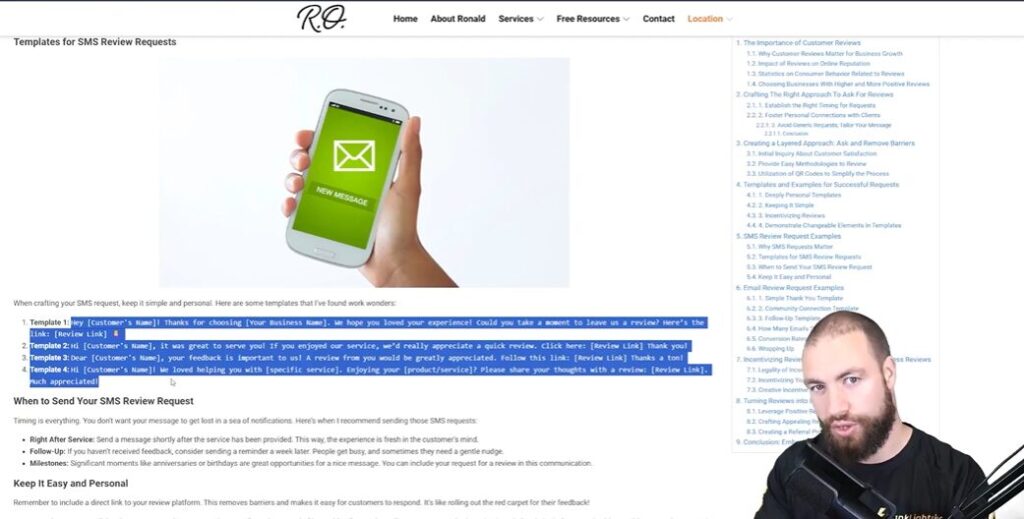
Creating content that attracts backlinks is no small feat. It’s essential to understand that content quality and structure play a pivotal role in this process. Think about it: would you link to a poorly written article? Probably not. High-quality content is not just well-written; it’s also informative and engaging. When I craft my content, I always aim for clarity and relevance. This approach resonates with readers and encourages them to share and link to my work.
The structure of your content also matters. A well-organized piece is easier to read and comprehend. I often use headings, bullet points, and lists to break up the text. This keeps readers engaged and helps them find the information they’re looking for quickly. In a world where attention spans are short, this is crucial. Wouldn’t you prefer to read something that’s easy to digest?
Now, let’s talk about examples of 'linkable' content. One of my favorite types is the ultimate guide. These comprehensive resources provide in-depth information on a specific topic. For instance, I created a guide on "The Benefits of E-Commerce SEO." It was structured with clear sections, subheadings, and actionable insights. This not only made it user-friendly but also appealing to other sites looking for reliable resources to link to.
Another example is data-driven content. When I include statistics or case studies, it adds credibility. People love sharing data that supports their claims. So, when I wrote about "The Impact of SEO on Small Businesses," I included relevant statistics. This approach made my content more attractive to others in the industry, leading to several backlinks.
Speaking of data, let’s not forget the power of visuals. Images, infographics, and charts can significantly enhance the appeal of your content. I often use visuals to break up text and illustrate key points. A well-designed infographic can summarize complex information in an engaging way. It’s shareable, too! When people see compelling visuals, they’re more likely to link back to my content.
Moreover, I’ve found that distributing my content on social media amplifies its reach. When I share my articles with eye-catching visuals, it attracts attention. Others are more inclined to share and link to my work. It’s a win-win situation! So, don’t underestimate the impact of visuals and data in your content.
In summary, creating content that attracts backlinks involves focusing on quality, structure, and the strategic use of visuals. By doing so, we can enhance our chances of earning those valuable links that boost our online presence.

When it comes to boosting the visibility of your content, I can’t stress enough how important it is to utilize every tool at your disposal. Let’s break down three effective strategies: using social media, networking with influencers, and leveraging press releases. These factors can also help attract backlinks for free.
Social media isn’t just a place to share cat videos. It’s a powerful platform for promoting your content. Think about it: billions of people scroll through their feeds every day. Why not tap into that audience?
Ever wondered why some posts go viral? It’s often due to the right mix of timing, engagement, and a little luck. But we can increase our chances by being active and responsive on these platforms.
Networking isn’t just for job seekers. It’s crucial for anyone looking to promote their content. When I connect with influencers or bloggers in my niche, I open doors to new audiences.
Remember, networking is a two-way street. I’ve found that offering value first often leads to mutually beneficial relationships.
Press releases can seem old-fashioned, but they still hold significant value. When done right, they can attract media attention and drive traffic to your content.
Think of a press release as a way to announce something exciting. It’s your chance to get noticed by a wider audience.
In conclusion, promoting your content requires a mix of strategies. By utilizing social media, networking effectively, and leveraging press releases, we can maximize our exposure and reach our target audience. Each of these methods builds on the others, creating a robust promotional strategy.

When it comes to link building, measuring success is crucial. How do we know if our efforts are paying off? What tools can we use to track our progress? In this section, I’ll share some insights on the tools and metrics that can help us gauge the effectiveness of our link-building strategies and attract backlinks for free.
First off, let’s talk about tools. There are several platforms out there that can help us monitor backlinks and assess site performance. Some popular options include:
Using these tools, we can keep an eye on our backlink profile and ensure we’re moving in the right direction. It’s like having a GPS for our SEO journey. Are we on the right path? Or do we need to reroute?
Next, let’s dive into traffic data. Interpreting this data is key to understanding how effective our content really is. When we look at metrics like page views, bounce rate, and average session duration, we can gauge how well our content resonates with our audience.
For instance, if we notice a high bounce rate on a page, it might signal that our content isn’t engaging enough. Or, if a particular piece is driving a lot of traffic, we should analyze what’s working. Are we addressing a specific pain point? Are we using engaging visuals? This data is invaluable.
Finally, we need to be willing to adjust our strategies based on the feedback and results we gather. If something isn’t working, why stick with it? I’ve learned that flexibility is key. If a certain keyword isn’t generating backlinks, it might be time to pivot. Perhaps we should try targeting a different keyword or changing our content style.
In the world of SEO, nothing is set in stone. As Ronald Osborne from Osborne Digital Marketing emphasizes, focusing on creating content that ranks number one can lead to more backlinks than high-quality content that sits lower in search results. It’s all about finding that sweet spot.
So, as we measure our success in link building, let’s keep these tools and metrics in mind. They’re not just numbers; they’re indicators of our growth and areas for improvement. With the right approach, we can refine our strategies and ultimately achieve our link-building goals.
When I first ventured into the world of SEO, the learning curve was steep, and the stakes felt incredibly high. I remember sitting in front of my laptop, overwhelmed by the jargon and endless lists of things to do. It was during this time that I discovered the immense value of SEO consulting and coaching - an option that not only saved me money but also empowered me to take control of my own marketing strategies. In this post, I want to dive deep into what SEO coaching and consulting truly entail and how they can be a game-changer for many businesses.
TL;DR: SEO consulting and coaching offer personalized guidance that empowers small business owners to improve their online presence. This post outlines the benefits, key considerations, costs, and who can benefit the most from these services.
When diving into the world of SEO, many business owners find themselves wondering about the best approach to take. Should they hire someone to handle everything, or is it better to learn the ropes themselves? This is where SEO coaching and consulting come into play. Let me break it down for you.
First off, let's clarify what SEO consulting and coaching really mean. SEO coaching is more about guidance. It’s a collaborative guide process where I work with clients to help them understand SEO strategies and how to implement them. On the other hand, SEO consulting often involves a more hands-off approach, where I might analyze a website and provide a detailed report, but the execution is left to the client.
In essence, coaching is about active participation. You’re not just sitting back and letting someone else do the work. You’re involved, learning, and applying what you’ve learned. Consulting might feel more like a one-way street, where you receive advice but are not as actively engaged in the process.
As an SEO coach, my role is to provide the insights and strategies you need to succeed. Think of it like a personal trainer. I can guide you on how to build your SEO muscles, but you have to do the heavy lifting. For example, if you want to know how many backlinks to build each month, I’ll analyze your situation and provide tailored advice. However, the actual task of building those links is up to you.
Many clients often ask me common questions during coaching sessions. These can range from:
These inquiries are crucial because they reflect the challenges many face when trying to improve their online presence. I help clients tackle these issues head-on, providing them with the tools and knowledge they need.
One of the major benefits of SEO coaching is the easy interactive learning experience it offers. Unlike traditional classes or one-off consultations, coaching allows for a back-and-forth dialogue. You can ask questions, seek clarification, and even pivot your strategies based on real-time feedback. This dynamic process helps solidify your understanding.
Moreover, many small business owners or startups find coaching to be a budget-friendly option. Instead of paying thousands for a full-service agency, they can invest in a few coaching sessions. This not only saves money but also equips them with the knowledge to manage their SEO independently.
Think about it: wouldn’t it be better to learn how to fish rather than just receiving a fish? With coaching, you’re learning the skills to navigate the SEO waters on your own.
In summary, SEO coaching and consulting are two sides of the same coin. While coaching emphasizes guidance and active participation, consulting provides expert advice with less direct involvement. Each has its place, but understanding the difference is crucial for anyone looking to enhance their SEO efforts.e their SEO efforts.
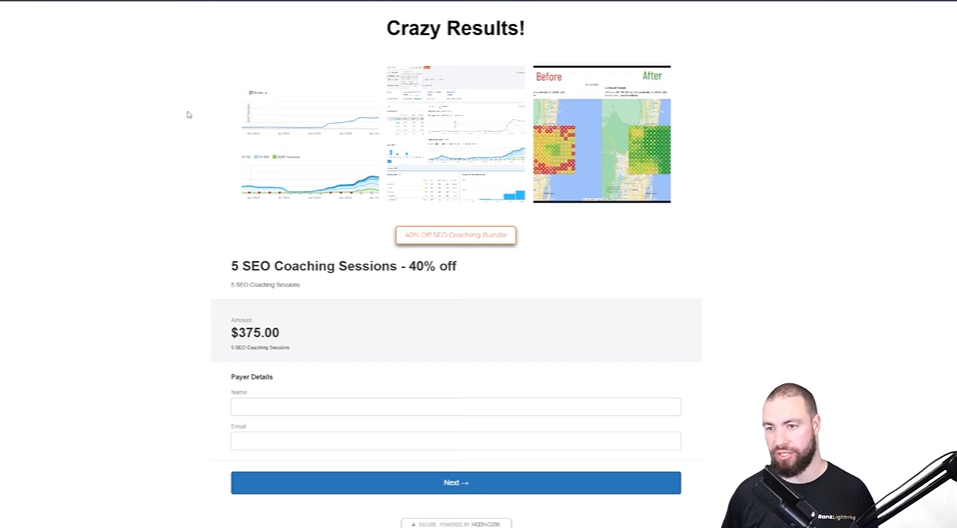
When it comes to SEO coaching and consulting, understanding the costs involved can be a bit of a maze. I’ve been in the digital marketing game for a while, and I can tell you that prices for SEO services can vary widely. So, let’s break it down together.
First, let’s talk about the typical pricing models for SEO coaching. Most professionals, like myself, charge by the hour. For instance, at Osborne Digital Marketing, I charge $125 per hour. This model allows clients to pay only for the time they need. However, there are also packages available. Some coaches offer bundled sessions at a discounted rate. This can be a great way to save money if you’re committed to a longer-term learning process.
But here’s a question for you: Have you ever considered how much you’re willing to invest in your business’s online presence? Think about it. SEO isn’t just an expense; it’s an investment. The right guidance can lead to significant returns.
Now, let’s dive into special promotional rates. Currently, I’m offering a fantastic deal: a 40% discount on my coaching services until the end of January. Clients can book five sessions for just $375, down from the usual $625. That’s a steal! Promotions like this can make high-quality coaching more accessible, especially for small businesses.
It’s essential to keep an eye out for these promotions. They can provide significant savings while still allowing you to receive expert guidance. Just imagine what you could achieve with a few focused sessions aimed at improving your SEO strategy!
Speaking of small businesses, let’s discuss the cost benefits of SEO coaching. Many small business owners often feel overwhelmed by the high costs associated with full-service SEO agencies. With prices sometimes exceeding $2,000 per month, it’s no wonder they seek alternatives.
SEO coaching offers a more budget-friendly option. It allows you to gain valuable insights and knowledge without the long-term contracts typical of comprehensive services. This is particularly beneficial for startups or small businesses that may not have the capital for extensive SEO services.
Imagine learning how to optimize your own website and engage in effective link-building strategies. That’s exactly what coaching provides - skills that empower you to take control of your SEO efforts.
Now, let’s compare one-on-one coaching with full-service SEO. One-on-one coaching is all about collaboration. You actively participate in the process, learning and implementing strategies as we go. This hands-on approach is fantastic for those who want to understand the ins and outs of SEO.
On the other hand, full-service SEO means handing over the reins. You might pay a hefty fee, but the agency takes care of everything. While this is convenient, it doesn’t provide the educational benefit that coaching does. Plus, if your SEO provider isn’t achieving results, you might be left in the dark about what’s working and what isn’t.
So, which is better for you? It depends on your goals. If you’re eager to learn and grow your skills, coaching could be the way to go. However, if you prefer to focus solely on running your business, full-service SEO might suit you better.
In my experience, many small business owners thrive when they engage in coaching. They gain confidence and knowledge, which translates into better SEO practices. And let’s face it, who wouldn’t want to be more in control of their online presence?
So, as you navigate the costs of SEO coaching services, consider your options carefully. The right choice can lead to greater visibility and success for your business.

When it comes to boosting your business's online presence, SEO coaching and consulting can be a game changer. I’ve seen firsthand how small business owners can benefit from this approach. But like anything, there are pros and cons. Let’s dive into the details.
First, let’s talk about the advantages. Here’s what I’ve found to be the most significant benefits:
For small business owners, especially those just starting, this can be a cost-effective way to enhance your online visibility.
However, it’s not all sunshine and rainbows when we talk about SEO consulting. There are limitations to consider:
These limitations can impact your overall experience, so it’s essential to weigh them carefully.
Before you jump in and hire a coach, consider these critical factors:
By focusing on these factors, you can make a more informed decision about who to hire.
Once you start your coaching sessions with an SEO consultant, it’s crucial to evaluate their effectiveness. Here’s how:
By keeping these points in mind, you can ensure that your investment in SEO coaching is paying off.
SEO coaching and consulting can be a valuable resource for small business owners looking to enhance their online presence. Understanding both the pros and cons will help you make the best decision for your unique situation.
Does your site have issues? You might be wondering if you need an SEO consultant's help. First, you'll need to assess your website or your business. If you do not have any knowledge about search engine optimization and you want your website to rank higher in search engine results compared to your competitors, you might need to call a trusted SEO consultant. If you notice a drop in your website traffic, you definitely need customized optimization strategies that fit your needs. Call an expert SEO agency if you need consulting services and resolve issues your website is facing.
To boost your website's ranking, it's crucial to have a clear SEO strategy that aligns with your business goals. Working with an SEO consultant can greatly improve your efforts, as they have the expertise and experience to navigate the intricacies of search engine optimization. By utilizing their insights, you can create a customized plan that not only enhances your website's visibility but also attracts targeted traffic to your online platform.
A solid SEO strategy includes several components, such as keyword research, on-page optimization, and link-building techniques. An SEO consultant can help you find the most relevant keywords for your industry, optimize your website's content and structure, and build a strong backlink profile. This teamwork will ensure that your website is effectively positioned on top of search engine results and in social media searches, leading to increased organic traffic and better overall performance in the digital space.
When data shows you've had a drop in organic traffic to your website and are thinking about working with an SEO consultant to improve your search engine rankings compared to your competitors. This situation calls for a strategic approach to pinpoint the issues affecting your website's visibility and to implement effective solutions that can attract more visitors.
Partnering with an SEO expert can offer you valuable insights, data, and customized strategies focused on enhancing your website's performance. By reviewing your current SEO practices and the competitive landscape, the consultant can assist you in creating a detailed plan that tackles essential areas like keyword research and optimization, content quality, and backlink strategies, ultimately resulting in better rankings and increased organic traffic.
As you face search engine optimization issues in the long run, it is better to get SEO consulting services most specially if your site has decreased traffic or your podcast hasn't been listened to in a while. Combined with email marketing, it can create a great impact for your SEO efforts. These specialists have undergone SEO training and has gone through case studies in order to gain more knowledge. There are a lot of SEO agencies and companies who offer good SEO consulting services. Find a highly recommended SEO consulting team near you and seek help to avoid potential SEO issues in the future.
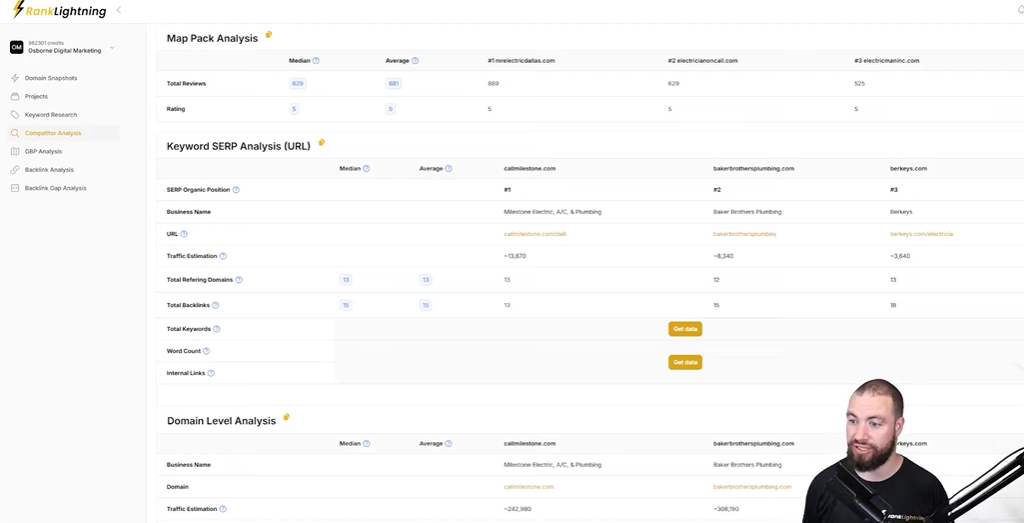
When it comes to enhancing your online presence, SEO coaching can be a game changer. But who exactly should consider it? Let’s dive into this topic together.
First off, let’s identify the ideal candidates for SEO consulting and coaching. Generally, small business owners and startups are the best fit. Why? Because they often have the time to learn but may lack the budget for full-service SEO agencies, which can charge thousands of dollars each month.
Now, let’s talk about the challenges small business owners face. It’s a tough world out there, especially in the digital space. Many struggle to keep up with the ever-changing algorithms of search engines.
These challenges can lead to frustration. I’ve seen it firsthand. Many business owners feel lost, unsure of how to improve their rankings. Coaching can provide the clarity they need.
So, how does SEO coaching align with business goals? It’s quite simple. By learning effective strategies, business owners can directly impact their visibility and, ultimately, their sales.
For example, let’s say your goal is to increase your website traffic. Through coaching, you’ll learn how to optimize your content, enhance your site’s structure, and effectively build backlinks. This hands-on approach means you’re not just paying someone to do it for you; you’re actively involved in the process.
“SEO coaching helps you connect the dots between your business goals and online strategies.”
Finally, let’s read success stories. I’ve had the pleasure of working with many clients who have seen remarkable transformations after engaging in SEO consulting services.
One client, a local electrician in Dallas, came to me frustrated. After just a few coaching sessions, they learned how to optimize their website and target specific keywords. Within months, their traffic increased by over 200%. They went from struggling to thrive in a competitive market.
Another success story involves a startup site that focused on eco-friendly products. They were unsure how to reach their audience. Through our coaching sessions, they developed a solid SEO strategy. As a result, their online sales skyrocketed, and they built a loyal customer base.
These stories aren’t just outliers; they’re examples of what’s possible with the right guidance. SEO coaching doesn’t just teach; it empowers.
So, if you’re a small business owner or a startup looking to enhance your online presence, consider SEO coaching. It might just be the boost you need to thrive in today’s digital landscape.
SEO isn't just all about finding the right keywords or doing the best practices for on and off page optimization. It is all about outranking your competitors and be on top of search engine results. Having an SEO consultation with a goal-driven expert team gives you an edge. They can recommend the right search engine optimization consulting services so you won't waste money on strategies that won't work and slowly achieve your SEO goals.
SEO consultants are essential for boosting a website's visibility and performance in search engine results. Their job includes a range of tasks, starting with keyword research to determine the most relevant and high-traffic keywords that target customers might use. This important step lays the foundation for a targeted strategy that aligns with the client's business goals and audience needs.
Beyond keyword research, SEO consultants perform technical services such as thorough SEO audits. These kind of projects evaluate the current state of a website's optimization, highlighting areas that need improvement in both on-page and off-page optimization. By examining factors like site structure, content quality, and backlink profiles, consultants can offer practical insights that help companies strengthen their online presence and enhance their search engine rankings.
Additionally, SEO consultants play an important role in executing effective content marketing strategies and link-building efforts. Content marketing focuses on producing high-quality, relevant content that not only draws visitors in but also keeps them engaged, leading to conversions. On the other hand, link building aims to secure backlinks from reputable sources, which is crucial for building authority and credibility with search engines. Together, these strategies form a comprehensive SEO approach that drives organic traffic and supports long-term business growth.
As we wrap up our discussion on SEO consulting and coaching, I want to take a moment to summarize the key takeaways. SEO consulting services is more than just hiring someone to do the work for you. It’s about collaboration. You engage with an expert, like myself, to understand and implement strategies that enhance your business's performance on search engines like Google. This approach empowers you to take charge of your own SEO journey.
One of the most important aspects of SEO coaching is self-assessment. I encourage you to ask yourself a few questions. Do you have the time and willingness to learn? Are you ready to actively participate in the process? If you answered yes, then SEO coaching could be a great fit for you. It’s designed for small business owners or startups who may not have the budget for full-service agencies but still want to improve their online presence.
If you’re intrigued and want to explore further, the next steps are simple. I invite you to book a free fifteen-minute discovery call with me. This call is an opportunity for us to discuss your specific needs and see how I can assist you in your SEO journey. Plus, I’m currently running a special promotion where you can book five coaching sessions for only $375. This offer is a significant discount from my regular rate of $625. But hurry, this promotion ends at the end of January!
SEO coaching allows you to access expert knowledge without the hefty price tag of hiring a full-service agency, which can cost upwards of $2,000 a month. You’ll gain insights and strategies tailored to your business without being locked into long-term contracts. However, it’s essential to remember that while coaching provides valuable guidance, it doesn’t offer ongoing support indefinitely. Five sessions can equip you with the tools you need, but you’ll need to be proactive in applying what you learn.
In my experience, the most successful clients are those who are eager to learn and willing to put in the effort. They take the time to understand their market and how to navigate the complexities of SEO. If you’re in a less competitive industry, coaching can be a game-changer. It’s a way to elevate your online presence without breaking the bank.
“SEO coaching is about empowerment. It’s about giving you the tools to succeed.”
In conclusion, if you’re ready to take the plunge into the world of SEO, I’m here to help. Whether you’re looking to build backlinks or improve your website’s visibility, we can work together to create a strategy that meets your needs. Don't let the complexities of SEO overwhelm you. Instead, view it as an opportunity to grow your business.
So, are you ready to make a move together with our team of SEO specialists? Don’t wait too long - my special offer is time-sensitive. Click the link below to schedule your discovery consult us and start your journey towards SEO success today!
When I first ventured into the world of SEO, I was overwhelmed by the flood of information regarding backlinks, their importance, and how to measure their impact. One day, I found myself questioning the concept of link velocity - a term I had heard thrown around in countless discussions. As I dug deeper, I realized just how pivotal link velocity is to successful SEO. Today, I want to share my insights with you, including a handy tool I've developed - a free link velocity calculator to streamline this process!
TL;DR: Link velocity is crucial for SEO success. My free backlink velocity calculator simplifies measuring and strategizing your backlink acquisition for better rankings.
Let's dive into the concept of link velocity. At its core, link velocity refers to the pace at which a website acquires backlinks. Think of it as the speed limit on the road to SEO success. If you go too fast, you might get pulled over. If you go too slow, you risk getting left behind. So, what does this mean for your website?
Link velocity is not just a fancy term; it’s a critical component of any successful SEO strategy. When we talk about link velocity, we’re looking at how backlinks are accumulated over time. This includes factors like:
It’s essential to monitor this because search engines like Google analyze link velocity to determine the legitimacy of a website’s link-building efforts. If you suddenly gain hundreds of backlinks in a week, it could raise a red flag. Think of it like a sudden influx of new friends on social media. It might look suspicious!
Now, why should we care about link velocity? Well, it plays a vital role in SEO rankings. Here’s why:
In my experience, I’ve seen websites that focus on consistent, gradual link acquisition often outperform those that attempt to rush the process. It’s like planting a tree. You wouldn’t expect it to grow overnight, right? You nurture it, and over time, it flourishes.
When it comes to link acquisition, there are generally two schools of thought: natural link acquisition and aggressive link building. Let’s break these down.
Natural Link Acquisition involves earning backlinks organically. This is often achieved by creating high-quality content that others want to link to. It’s about building relationships and providing value. When you take this approach, you’re likely to see a steady increase in link velocity over time.
On the other hand, aggressive link building focuses on obtaining a large number of backlinks in a short period. This method can be tempting, especially when you’re eager to see results. However, it can backfire. Search engines may interpret this sudden spike as unnatural behavior. This could lead to penalties or a drop in rankings. It’s like trying to sprint a marathon. You might start strong, but you won’t finish well.
To illustrate, let’s say you’re targeting a competitive keyword, like “electrician Dallas.” If you suddenly acquire hundreds of backlinks in a week, Google might flag your site as suspicious. Instead, a more measured approach - building a few quality links each month - is often more effective.
As Ron from Osborne Digital Marketing points out, “If someone were to build out all backlinks in a short time, Google might flag this as unnatural behavior.” It’s essential to set realistic expectations. SEO is a marathon, not a sprint.
In conclusion, understanding link velocity can significantly impact your SEO strategy. By focusing on natural link acquisition and maintaining a steady pace, you can enhance your website's trustworthiness and improve your rankings over time. Remember, it’s not just about the quantity of links; it’s about the quality and how you acquire them.
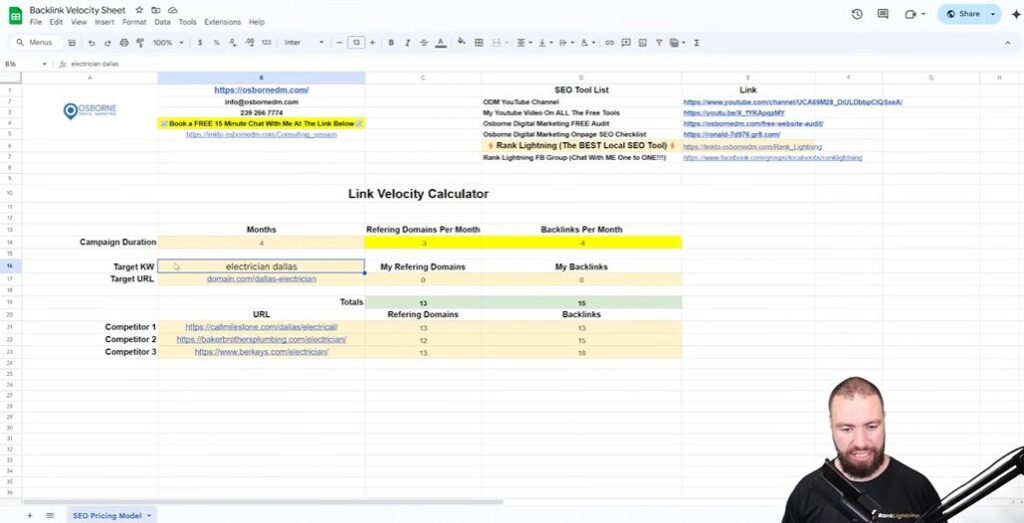
When I first stumbled upon the Backlink Velocity Calculator, I was intrigued. This tool is a game changer in the realm of SEO. It helps you understand link velocity, which is simply the speed at which you acquire backlinks. Think of it as a pulse check for your website's health in the search engine world. Too fast? You might get penalized. Too slow? You could be left behind.
One of the standout features of this calculator is its user-friendly interface. It has different sections that are color-coded for easy navigation. The green sections automatically generate data based on your inputs, while the yellow sections require you to fill in specific information. This makes it accessible for both beginners and seasoned pros alike.
Ready to dive in? Here’s a simple step-by-step guide to using the Backlink Velocity Calculator:
By following these steps, you can effectively harness the power of the calculator to improve your link-building strategy.
Now, let’s talk about the importance of competitor data. Understanding what your competition is doing can give you a significant edge. Ron emphasizes that by inputting data from your competitors, you can gauge how many referring domains and backlinks you need to achieve your goals.
Here’s how to do it:
By incorporating competitor insights, you can create a more effective and targeted backlink strategy. It’s not just about what you have; it’s about understanding the landscape.
In the end, the Backlink Velocity Calculator is more than just a tool. It’s a roadmap for your SEO journey. It helps you set realistic expectations and encourages a data-driven approach. After all, SEO is not just about speed; it’s about strategy. By taking the time to analyze your link-building efforts, you’ll be better equipped to navigate the complexities of search engine optimization.
So, are you ready to take your backlink strategy to the next level? The Backlink Velocity Calculator is waiting for you!

When it comes to SEO, understanding link velocity is crucial. But what exactly is link velocity? Simply put, it's the speed at which you acquire backlinks. If you’re not careful, you could fall into some common pitfalls. Let’s explore these pitfalls and strategies to maintain a healthy link profile, along with some real-life examples that can guide us.
We often think that more links mean better rankings. But that’s not always true. One of the biggest mistakes is acquiring too many backlinks too quickly. Think of it like running a marathon. If you sprint at the start, you’ll tire out long before the finish line. The same applies to link building.
Ron from Osborne Digital Marketing emphasizes that “if someone were to build out all backlinks in a short time, Google might flag this as unnatural behavior.” This can lead to penalties that hurt your rankings.
Now that we’ve covered the pitfalls, let’s talk about strategies to keep your link profile healthy. Here are some practical tips:
By following these strategies, you can build a robust link profile that stands the test of time. Remember, it’s about quality over quantity.
Let’s look at some real-life examples to see these strategies in action. One local business, an electrician in Dallas, focused on building relationships with local bloggers and industry influencers. Instead of chasing after hundreds of links, they targeted a few high-quality sites. This approach not only improved their link profile but also increased their local visibility.
Another case involved a small e-commerce store that created a series of how-to guides related to their products. They shared these guides on social media and reached out to relevant websites for backlinks. Over time, this strategy built a diverse and healthy link profile, leading to improved rankings and sales.
These examples show that with the right approach, it’s possible to manage link velocity effectively. It’s not just about getting links; it’s about getting the right ones.
In conclusion, managing link velocity is a balancing act. A backlink velocity calculator may be a helpful tool. You need to be strategic in your approach to avoid common pitfalls while focusing on quality and diversity. By setting realistic goals and utilizing tools for analysis, you can build a healthy link profile. Remember to learn from real-life examples and adapt your strategies accordingly. SEO is not a sprint; it’s a marathon. With patience and the right tactics, you can achieve sustainable growth without risking penalties. Let’s keep our link-building efforts smart and effective!
When I first stumbled into the digital marketing arena, all I could think about was how to attract clients and maximize my profits without burning out. The learning curve was intense, but then I discovered white label SEO services. If you're a newbie like I once was, let me take you on a journey through the wonderful world of outsourcing SEO and how it can transform your agency's success. We will discover more on the benefits of white label SEO services.
TL;DR:White label SEO allows new agencies to focus on client acquisition while outsourcing technical work, enhancing efficiency and profitability.
White label SEO services are a game changer for agencies and freelancers. But what does that really mean? Essentially, it’s about outsourcing SEO tasks to a third-party provider while you present the work as your own. Think of it like hiring a chef to prepare a meal that you serve at your restaurant under your name. This allows you to focus on what you do best - acquiring clients and managing relationships - while the SEO experts handle the technical work. We will dive deeper into the details of what is white label SEO and how it can benefit clients.
So, why should agencies consider outsourcing their SEO needs? Here are a few compelling reasons:
Providers such as Osborne Digital Marketing play a crucial role in this ecosystem. They take the heavy lifting off your shoulders. You don’t have to worry about learning every detail of SEO or investing in an SEO platform and expensive tools. Instead, you can offer your clients high-quality services without the stress.
For instance, if you were to manage an SEO project yourself, you might spend around 30 hours on it. That’s four full days! Plus, you have to factor in costs for tools, which can eat into your profits. By outsourcing, you can keep your profits higher and your workload manageable.
White-label SEO services are especially beneficial for those just starting out. If you have only one or two clients, it might not make sense to invest heavily in SEO tools or labor. Instead, you can leverage a provider’s expertise. However, if you have a solid client base - say, 10 to 15 clients - you might want to consider managing some aspects yourself or selectively outsourcing. Practically speaking, it is much cheaper to take advantage of white labeling SEO than building your own team for a start-up.
When looking for a white label provider, it's critical to do your homework. Check their track record and the process on how they conduct their services as a team. Search for case studies and proven results. Remember, I don’t brand myself as an SEO expert. I see myself as a businessman. This perspective can help you evaluate potential partners more effectively.
For those who need further guidance, I offer free resources including an SEO pricing model and an ROI calculator. Feel free to reach out and connect with me through my Facebook group, the Rank Lightning Facebook group. I'm here to help you navigate the complexities of white label SEO.
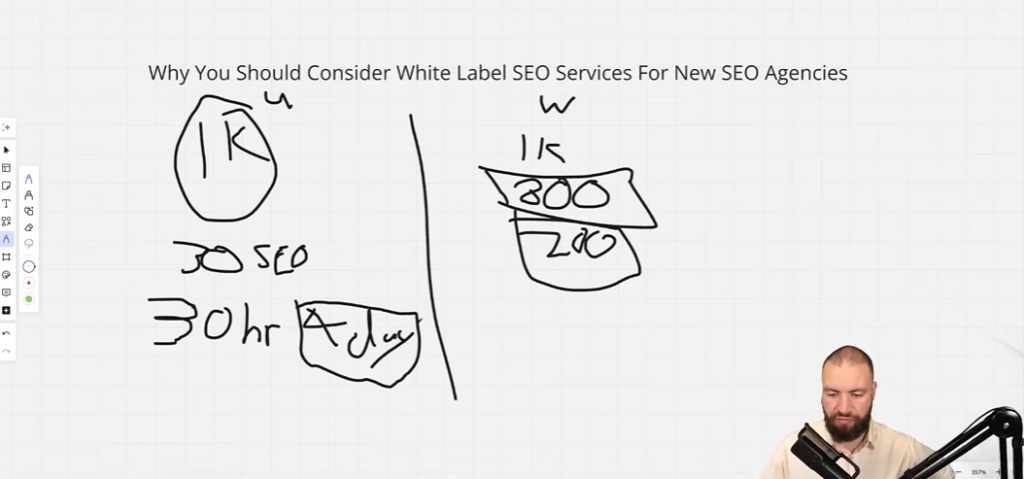
When it comes to SEO, many of us face a crucial decision: should we handle it in-house or outsource it? Let’s break down the costs of getting SEO services.
Imagine you have a client willing to pay $1,000 for SEO services. If you choose to outsource this to a white label provider, say Osborne Digital Marketing, for $800, you’re left with $200. That’s $200 for managing client meetings, reporting, and nurturing the relationship. Sounds good, right?
Now, consider doing it yourself. If you charge $30 an hour, you’d need to spend around 30 hours on the project. That’s four full days! Add in essential tools like Rank Lightning, which costs about $100 a month, and your profit margins start to dwindle. You might end up with just $700 for the month after all expenses. Not great and ideal.
Let me share a quick story. Early in my journey, I tried managing everything myself. I had a couple of clients, and I was excited to impress them with the results. However, I quickly realized that juggling client meetings and onboarding, SEO tasks, and doing monthly reporting was overwhelming. I was burning the candle at both ends.
By outsourcing to a white label provider, I could focus on what I do best: building relationships. The SEO work was handled by a team of experts, and I could present the results as my own. My clients were happy, and I had more time to take care and grow my business. It was an easy win-win situation.
Now, let’s talk about ROI. Time is money, right? When I analyzed my expenses and the time spent on SEO, the numbers were eye-opening. By outsourcing, I could save valuable hours. Instead of spending days on SEO, I could use that time to acquire new clients or enhance my service offerings.
In conclusion, the financial advantages and benefits of white label services are clear. They allow you to maximize your returns while minimizing the stress of managing every little detail. And if you’re new to SEO, this approach can be a game-changer.ss of managing every little detail. And if you’re new to SEO, this approach can be a game-changer.
As you flip the first page to build your own digital marketing agency, the whole process might overwhelm you. This is where white label SEO providers come to the rescue. It may be risky to entrust some major aspects of SEO to these service providers, but it can also benefit you in the long run. One significant advantage I've noticed is scalability. White label SEO allows agencies to grow their client base and offer comprehensive SEO services without worrying about operational overload. For a starter, it may be very expensive to build one whole SEO team right away. That's why this is particularly advantageous for small to medium-sized agencies that might not have the resources to handle a large volume of work.
Working with a reputable white label SEO provider ensures that tasks are carried out by professionals. This basically means you pay for the expertise of a knowledgeable team to perform and deliver a certain service. They make sure every page of your site is clean and optimized. From my experience, this results in higher quality services, which can improve client satisfaction and retention. Agencies can leverage the expertise of these firms to implement outstanding SEO strategies without needing to hire specialized staff.
White label SEO services certainly offer a range of benefits for your business and website, but there are also challenges to consider. It's important to recognize some potential downsides that could arise. If caution isn't taken when choosing the right agency, these issues may become evident.
Many people have concerns about working with a white label agency due to the perceived loss of internal oversight and below standard results that comes with these partnerships and their service. There can be uncertainty about the SEO methods these agencies use for website assessments or keyword research. Clients might find themselves unable to specify which blogs to target for backlinks. As a result, they must trust the agency to prioritize their best interests, hoping they will follow ethical practices instead of resorting to spammy links or shortcuts that could harm the client's reputation with Google. Working with a less reputable white label agency can also complicate communication, making it harder to ensure that the quality of work meets the business's expectations.
The reliability of white label agencies can differ greatly, and not all agencies uphold the expected standards. Their operational processes may lack transparency, making it challenging to determine if they follow industry best practices. When partnering with an agency that falls short, especially in terms of communication, clients may face delays in project completion. This communication breakdown can lead to longer turnaround times, missed deadlines, and ultimately, dissatisfaction among the client's customers.

In the world of digital marketing, white label SEO services can be a game-changer. But who exactly should consider using these SEO services? Let’s break down the benefits of white label SEO services to its potential market.
If you’re just starting out in the SEO field, white label services offer a smooth entry point. You might be overwhelmed by the technical aspects of SEO. Instead of diving headfirst into complex strategies, why not partner with an experienced provider, agency, or company? This way, you can focus on building client relationships while leaving the technical work to the pros.
Are you running a small agency? Maybe you’re a web developer or a social media manager. If you have limited time and resources, white label SEO can be a lifesaver. Think about it: if you have $1,000 for a client's SEO needs, and you outsource for $800, you still pocket $200. That’s a smart way to manage your finances while ensuring quality service for your clients.
If you’re juggling just a couple of clients, investing in expensive SEO tools might not be wise. Instead, consider white label solutions. You can provide high-quality services without the hefty price tag. It’s a win-win!
For those with a solid client base - let’s say 10 to 15 clients - white label SEO can help you scale your operations. You might have the expertise to handle SEO, but outsourcing certain tasks can free up your time. This allows you to focus on strategy and client satisfaction rather than getting bogged down in the nitty-gritty.
As a business owner, time is money. If you find yourself stretched thin, white label services can help you manage your workload. By outsourcing SEO, you can concentrate on what you do best - growing your business. Think of it as delegating the heavy lifting while you steer the ship.
Let’s be honest; not every SEO provider is created equal. When choosing a white label provider, look for credibility. Search for companies that can showcase their success stories in local SEO. A solid track record in the competitive SEO landscape is essential. After all, you want to ensure your clients receive top-notch service.
In summary, white label SEO services are ideal for a variety of individuals and agencies. Whether you’re new to the game or looking to scale your existing operations, these services can provide the support you need. So, why not explore how white label SEO can fit into your business strategy? It might just be the solution you’ve been searching for!
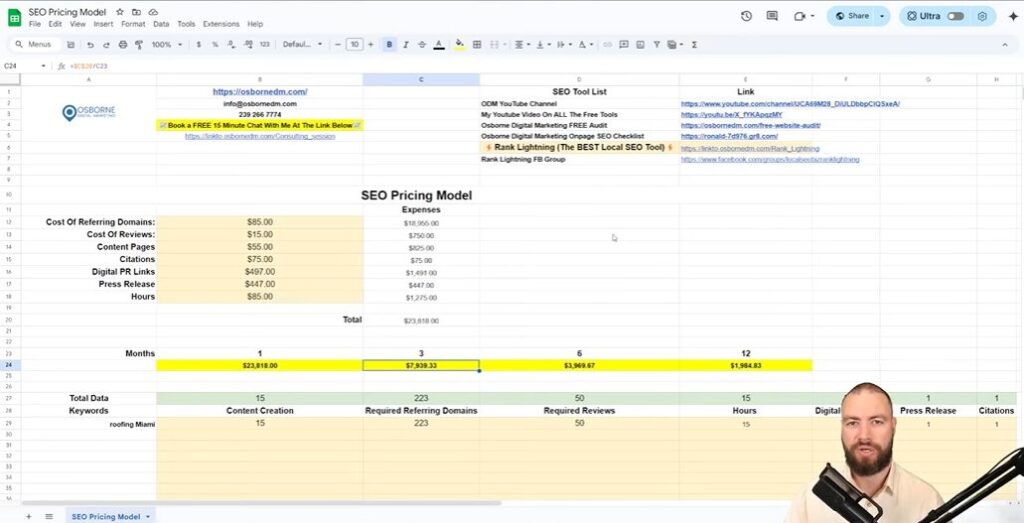
When I think about partnering with a white label SEO provider, I realize how crucial it is to search for and choose the right one. It’s not just about getting the job done; it’s about finding someone who aligns with your business values and goals using the most appropriate SEO campaign. So, let’s dig deeper into some essential criteria for vetting SEO service providers.
First off, you need to look for experience. A seasoned provider will have a track record of success. Ask yourself: Have they worked with businesses similar to yours? Do they understand your niche? Look for providers that can demonstrate their expertise in your industry.
Next, let’s talk about case studies. These are your best friends when evaluating a potential partner. They provide concrete evidence of success such a blog or service landing in the first page of search engine results. I often say, “The proof is in the pudding.” If a provider can showcase how they've helped other clients achieve their goals, it’s a good sign.
Search for metrics like:
Before signing any contracts, ask the right questions. This is where you can really gauge if a provider is the right fit for you. Here are some questions I recommend:
In conclusion, choosing the right white label partner is a significant decision. By considering these criteria, checking case studies, looking for reviews from past customers, and asking the right questions, you’ll be well on your way to finding a partner that can help you thrive in the competitive world of SEO.
As I wrap up this discussion on the benefits of white label SEO services, I want to encourage you to consider these services strategically. It’s more than just outsourcing; it’s about building a foundation and taking into account for your team or agency’s future. Think about it: are you looking for quick wins, or do you want to create something sustainable? A long-term growth mindset is crucial in this industry. Short-term gains can be tempting, but they often lead to burnout and missed opportunities.
When I first started my journey, I was hesitant about outsourcing. I worried about quality and whether my clients would be satisfied. But then I realized something important: outsourcing doesn’t mean losing control. It means gaining time to focus on what really matters - client relationships and growing your business. By partnering with a reputable white label service, you can deliver quality work without sacrificing your sanity.
Let’s say you have a client who needs SEO support. If you’re spending countless hours trying to manage everything yourself, how much time do you have left for your other clients? The answer is often not enough. By outsourcing to a team of experts and company like Osborne Digital Marketing, you can focus on client meetings and strategy while they handle the heavy lifting. It’s a win-win situation.
My personal anecdote about outsourcing comes from my early days. I was terrified of handing over control. What if their SEO team didn’t deliver? What if my clients were unhappy? I took the leap anyway, and it transformed my business. I learned to trust my partners and, in return, I gained more time and resources. Today, I can confidently say that outsourcing some SEO tasks has been one of the best decisions I’ve made.
In the end, leveraging white label SEO services can be a game changer for new agencies. It allows you to provide quality services without the overhead of hiring full-time staff or investing heavily in tools. Remember, it’s not about doing everything yourself; it’s about doing what you do best and letting others handle the rest. As I often say, “Focus on your strengths, and let your partners handle the weaknesses.”
So, as you contemplate your next steps, think about how white label SEO can fit into your strategy. It’s not just about saving time; it’s about positioning yourself for long-term success. Embrace the opportunity, and you’ll find that your team or agency can thrive in ways you never imagined.
When I first started navigating the world of online marketing, I had no idea how much a simple Google business profile could impact my business. It was a game-changer when I figured out how to add my social media links. Trust me, I felt like a digital wizard! In this post, I'll share that magic with you by showing you how to do it quickly and easily.
TL;DR: Learn how to add social profiles to Google Business Profile in a few simple steps, enhancing your online presence and accessibility.
It’s time we take charge of our online presence. To get started, I recommend accessing your Google Business Profile via the Google homepage. This is where it all begins. Just open a blank page in your browser and head over to Google.
You’ll notice a grid of dots in the top right corner of the screen. This is your gateway to all Google apps. Click on those dots, and you’ll find your Google Business Profile listed there. It’s like discovering a treasure chest hidden in plain sight!
Once you’re in your profile, editing your profile is the first step. This is where you can make all the necessary adjustments to showcase your business. For example, you can update your information, add photos, or even include important links. A well-curated profile can make all the difference!
Remember, a well-optimized Google Business Profile can help draw in potential customers. Why wait? Dive in and let’s start enhancing your business visibility today!
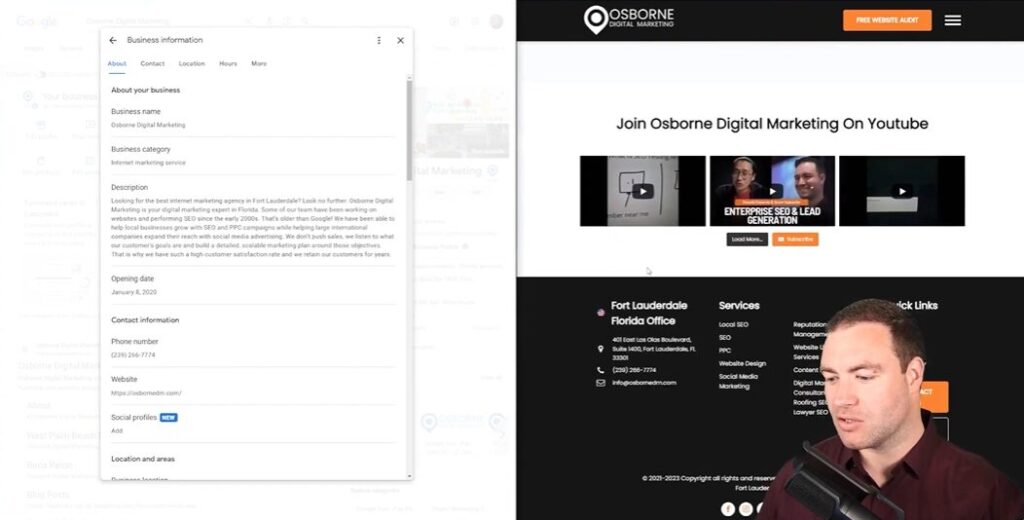
When I decided to enhance my Google Business Profile, I knew it was essential to add my social links. But where to start? Let's break it down into manageable steps.
First things first. I always recommend gathering all your social media links beforehand. This step saves time and avoids that frantic scramble to find your profiles. Most often, you can find these links at the bottom of your business website. They're usually listed neatly, ready to be copied.
Next, I logged into my Google Business account. It’s super easy: I just clicked on the dots icon for Google apps and selected my profile. Time to edit!
On the left side, I found the edit profile option. Now came the fun part: adding those freshly gathered social links.
With the links ready, I discovered how helpful the drop-down menu was. I started with my Instagram. I right-clicked my link, copied it, and pasted it into the designated field. Easy, right?
After I added each one, I clicked save. And just like that, my profiles were linked! Simple steps on how to add social profiles to Google Business Profile and a little preparation go a long way.
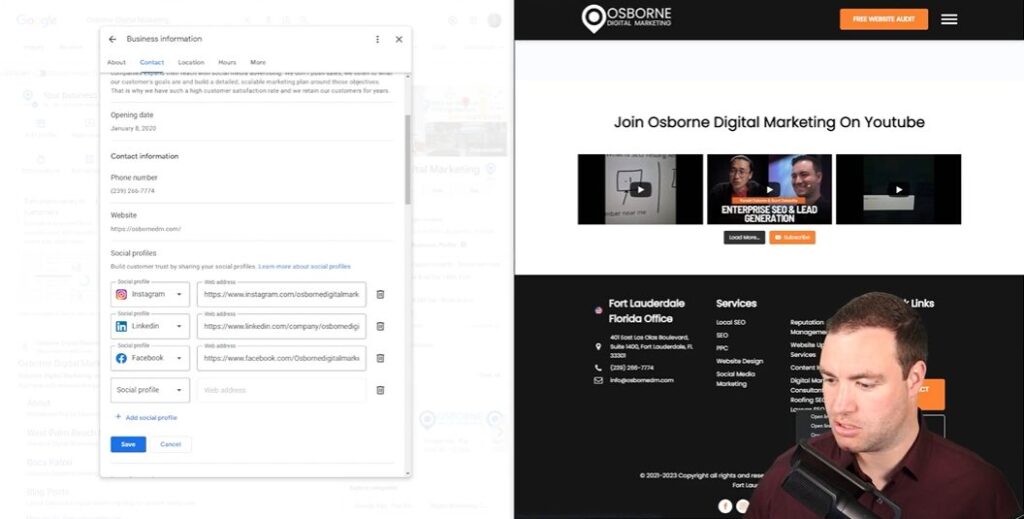
When it comes to enhancing your online presence, integrating social links is crucial. Here’s how I approach it.
First things first: choose your social media wisely. It’s tempting to flaunt every account you have, but I’ve learned that clutter only confuses potential customers. Do you want your audience to see your personal adventures on social media? Probably not. Focus on platforms that represent your brand best.
For example, if your business thrives on visuals, Instagram might be your go-to. If it’s about professional networking, LinkedIn can shine. Be selective. Quality over quantity, right?
How many times have you landed on a social profile only to find different logos, fonts, or messages? It’s unsettling. Consistency builds trust with your audience. I always ensure the same profile picture, bio, and tone across all platforms.
In doing so, you create a cohesive brand experience. It’s easier for your followers to recognize you and feel connected. Imagine walking into a store decked in mismatched colors. You wouldn’t feel comfortable, would you?
When adding your social links, you can streamline the process significantly by preparing them ahead of time. You can gather these links from your website’s footer, where they’re often listed.
Using these practices not only helps you maintain a professional image but also engages users more effectively. Try them out and watch your audience grow!

Once you've shared your insights, your work isn't finished yet. Engagement is crucial! We need to consistently monitor our Google Business Profile for both inquiries and reviews. This step could be the difference between building rapport with customers or losing them. Think about it: how would you feel if you reached out to a business and never got a response?
The key here is to respond quickly. A prompt reply can turn a curious visitor into a loyal customer.
Don't forget about your social media platforms! Regularly updating and interacting on linked channels makes a significant impact. Post relevant content and engage with your followers. Ask questions or create polls to encourage interaction. Consider this: what keeps you coming back to social media accounts? It’s the connection, right?
By actively participating, we can remind our audience we’re not just a brand; we’re a community. This ongoing engagement builds trust and can strengthen our online presence. Let’s ensure our voice is heard loud and clear! Remember, it’s all about creating lasting connections.
In today's digital age, social links are more than just external connections; they are vital gateways to business success. By learning how to add social profiles to Google Business Profile, you enhance visibility, build credibility, and foster customer engagement. Think of it this way: social links act as the bridge that connects you with your potential clients. Without them, that connection can become weak or even non-existent.
Taking action is key. I encourage you to invest time in this process. Start by preparing your social media links. If you need a quick win, check your business website’s footer where these links are usually tucked away. It’s a simple task that can have a significant impact.
Remember, every step counts. By adding these social links, you're not just updating a profile; you're paving the way for stronger relationships with your potential clients and audience. So, let’s get started! Your future customers are waiting. Make those connections today!
As someone who has spent years perfecting my website and content through the right SEO strategies, it was shocking to discover a competitor using my words and images as if they owned them. It felt like an invasion, and I quickly found myself on a mission to restore my reputation online. In this blog post, I’m going to share the exact steps I took to confront those copycats and get my website taken down.
TL;DR: If someone has stolen your website content, follow these actionable steps on how to get a website taken down and protect your intellectual property.
Content theft refers to the unauthorized copying and use of someone else's creative work. This can include text, images, videos, or even music. When individuals or companies take your content without permission, they are essentially claiming it as their own. This might seem like a minor issue, but it's a serious problem in today's digital world. Think about it: if you have worked hard to create something original, wouldn't you want the credit for it?
Identifying content theft can be tricky, but here are some common signs:
Protecting your content is crucial for several reasons. First, it safeguards your intellectual property. You’ve put time and effort into creating it, and it deserves to be respected. Secondly, it helps maintain your credibility. When others see your work being copied, it can undermine your reputation and the trust you've built with your audience. Lastly, protecting your content ensures that you can continue to monetize your efforts without undercutting competitors who steal your ideas. The loss of traffic, leads, and revenue is significant.
In my experience, documenting the infringement is the first step. I create a spreadsheet with each copied URL and the original URLs. This documentation not only helps you take action, but it also serves as a historical record.
It’s also a good idea to familiarize yourself with reporting processes. Whether you choose a paid DMCA route or a free complaint with Google, understanding your options will empower you to fight back against content theft effectively.
Remember, every creator deserves to see their hard work honored and protected. Don’t let others ride on your coattails!

When I discovered that my content had been stolen, the first thing I did was take a deep breath. This happens to many creators, and the best way to address it is to act fast. Today, I want to share my process on how to document everything meticulously. This is crucial to defend yourself against content theft.
The first step is organization. Create a detailed spreadsheet to track everything that’s been copied. I use Google Sheets because it's easy to share and access from anywhere. Include columns for:
Why is this important? Think of it like building your case. The more detailed your spreadsheet, the easier it becomes to report the infringement later.
Next, I recommend capturing screenshots. This step is vital. Not only do screenshots serve as evidence, but they also freeze the content in time, just as it appeared during the theft. Use your phone or a tool like Snagit for high-quality images. I usually take snapshots of:
Having these images puts you in a stronger position. You can easily show what was copied, which won't be disputed.
Don't forget to keep an accurate record of all URLs. Each one needs to reflect both the stolen content and your original writing. I usually add a column in my spreadsheet dedicated to this. When you're ready to report the infringement, you’ll be grateful for this detailed documentation.
Why is this detail so crucial? Because, without specific URLs, your complaint may lack the clarity needed for authorities to act promptly. You want everything to be crystal clear, don’t you?
In essence, keeping meticulous records can make a significant difference. When you experience content theft, it's easy to feel overwhelmed. But by following these steps, I believe you will empower yourself and stand a better chance at resolving the situation efficiently.
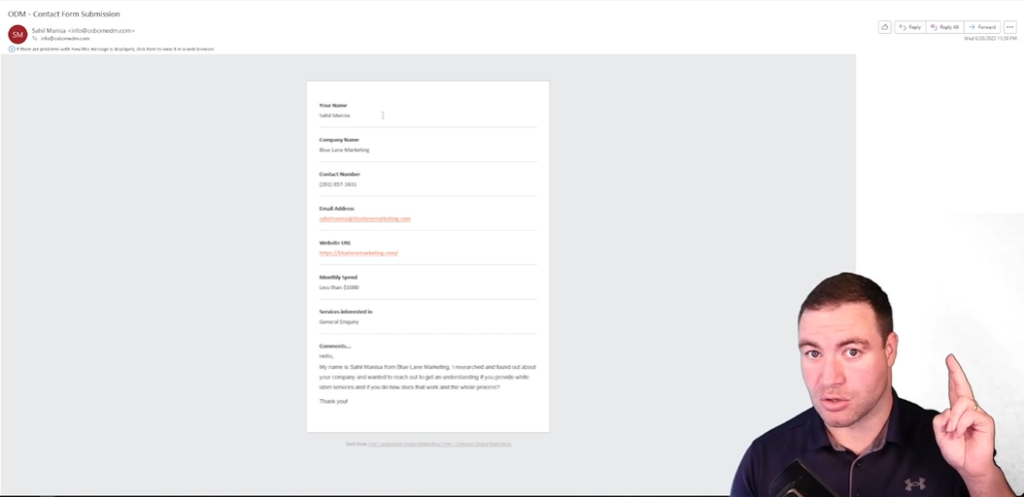
When you discover someone has copied your content, it’s a tough situation. Should you confront this copycat? My experience tells me that it can be a double-edged sword. Let’s break it down together.
Before you hit that send button, consider the following:
So, is it worth the effort? That's a personal choice.
If you decide to go ahead, what do you say? Here are some tips:
Remember, it’s all about communication. A well-structured message can mean the difference between compliance and conflict.
Now, let’s talk legal stuff. Reaching out can have its repercussions. Here’s what to keep in mind:
In summary, contacting the copycat has its risks and rewards. Take your time to assess the situation. I’ve learned the importance of acting wisely and knowing your options. When it comes to protecting your work, every detail counts.
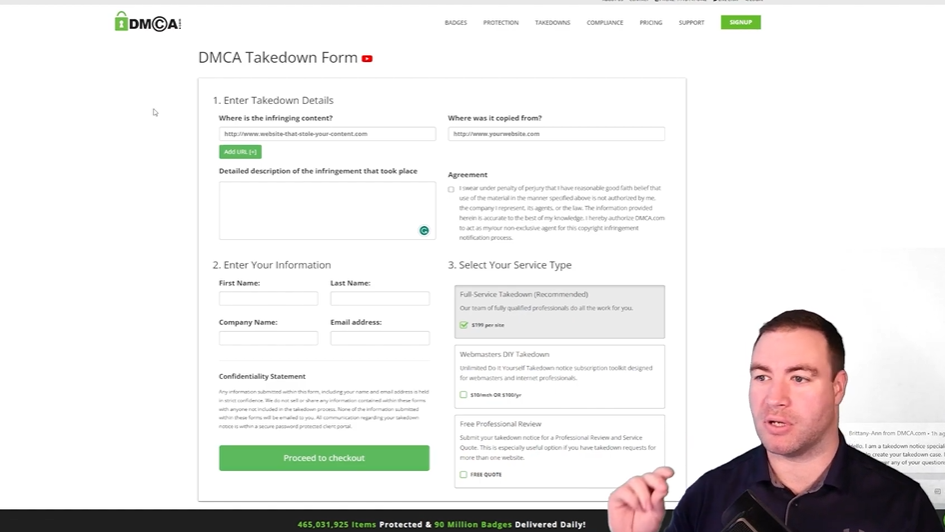
The Digital Millennium Copyright Act (DMCA) serves as a crucial tool for content creators. It was enacted to protect digital copyrights and set guidelines for handling copyright infringement online. Essentially, if someone steals your content, the DMCA provides a legal path to help you address the issue.
Why should we care? The internet is filled with content thieves. They copy and paste without a second thought. Investing time in creating unique content deserves protection. The DMCA gives you the power to take action on how to get a website taken down when someone crosses that line.
So, you’ve discovered your content is being used without your consent. What next? Filing a DMCA takedown notice is usually the way to go. Here’s a simple step-by-step process I recommend:
Make sure to be thorough. You want to leave no room for misunderstanding. And remember, the goal is to make them aware of their infringement and request the removal of your content.
Now, let’s talk about costs. Filing a DMCA takedown notice can be free if you do it yourself. However, many choose to use paid services, which can cost around $200. Why pay? Because these services streamline the process. They handle submissions to search engines and could expedite removal.
But are they effective? In many cases, yes! They know the ins and outs of the process. They take away the hassle of figuring it out on your own.
Nevertheless, success isn’t guaranteed. Sometimes the infringing party may ignore your notice. Documenting everything remains crucial. You may have to up the ante with legal actions, but that's a last resort.
In digital content creation, knowledge is power. Understanding the DMCA, knowing how to file a takedown notice, and being aware of costs will equip you in your fight against content theft. And always remember, you’re not alone in this struggle.

When you face content theft, knowing how to reach the right people is crucial. One critical step in this process is contacting the offender's domain registrar. This is where I come in to share my insights on how to navigate this.
First things first: you need to find out who registered the offending website. I recommend using tools like Whois lookup services. These sites allow you to enter the URL of the plagiarizing site to reveal the registrar details, including the name, contact information, and sometimes even the address.
Isn't it interesting how much information is out there? Sometimes, just hitting a few buttons can guide you to the right place.
Now that you have the registrar's details, it’s time to craft your message. I suggest being concise but thorough. Here’s what to include:
Remember, keep your tone professional. Registrars deal with many complaints daily, and a clear, polite message can go a long way.
What happens once you’ve sent your communication? Well, the registrar has several options:
However, I must share a word of caution. The registrar's actions can be hit-or-miss. Sometimes, they’ll act swiftly; other times, you might feel left in the dark. It’s important to stay patient but persistent. Remember, you're fighting for your rights here!
In my experience, combining your approach with filing a complaint with Google can amplify your impact. But that's a conversation for another time.
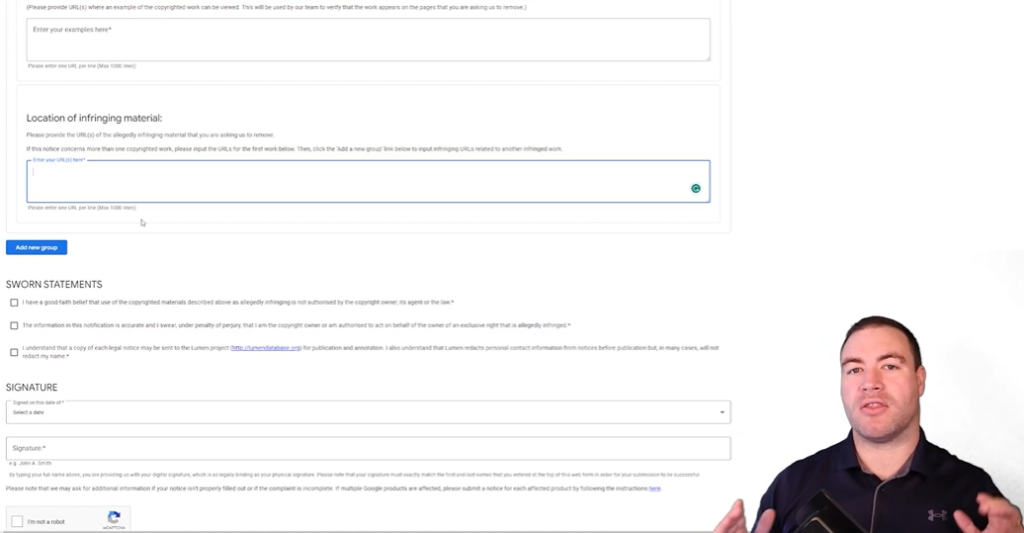
When you find someone has copied your content, it can feel overwhelming. I’ve been there. In my journey to protect my work, I’ve learned how essential it is to understand how to navigate the copyright infringement process, especially when it comes to Google. So, let’s break it down step by step.
First things first, I recommend going straight to Google’s Copyright Complaint form. It might seem daunting at first, but it’s straightforward once you know the steps.
Once you submit the form, Google will begin their review. Hang tight; it may take some time for them to respond.
Now, let’s talk about the information you’ll need:
It’s important to be as clear as possible. If this sounds like too much, think of it like putting together a case: you need evidence that can’t be ignored.
After filing your complaint, you might wonder what happens next. Here’s what Google typically does:
It’s a waiting game afterwards. But if Google finds merit in your claim, they take action. Remember, this isn't just about taking down a web page; it's about protecting your hard work. We owe it to ourselves and our creativity to stand up against infringement!

Getting involved with legal matters can be daunting, but there are moments when you simply can't do it alone. It’s essential to know the signs that indicate it’s time to bring a lawyer into the mix. Trust me, I’ve been there.
There are a few situations that might scream, “Get help!” Here are some signs to look out for:
You may be wondering what can happen if you get involved in legal action. Well, the possibilities are varied:
Finding the right legal support shouldn’t feel like searching for a needle in a haystack. Here’s what I found helpful:
It’s vital to take action if you sense that things are slipping out of your control. Engage a legal professional who can navigate the murky waters for you.
Remember, being proactive is key. When someone infringes upon your hard work, don’t hesitate to take the necessary steps on how to get a website taken down. Whether you pursue legal action or simply consult with someone knowledgeable, taking action ensures that you protect your interests effectively. Stay vigilant, and don’t hesitate to seek support.